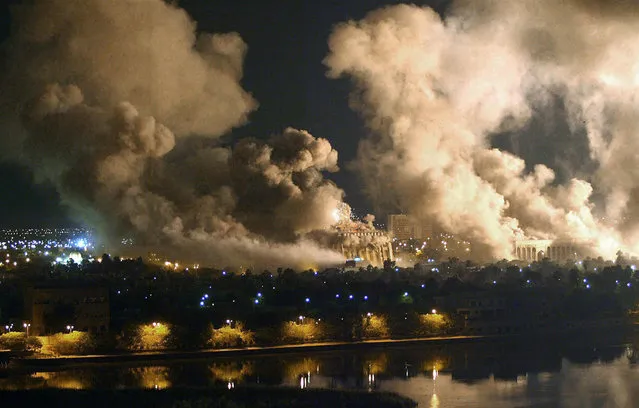
Smoke covers Saddam Hussein's presidential palace compound during a massive US-led air raid on Baghdad, Iraq on March 21, 2003. Allied forces unleashed a devastating blitz on Baghdad, triggering giant fireballs and deafening explosions and sending huge mushroom clouds above the city center. Missiles slammed into the main palace complex of President Saddam Hussein on the bank of the Tigris River, and key government buildings. (Photo by Ramzi Haidar/AFP Photo via The Atlantic)
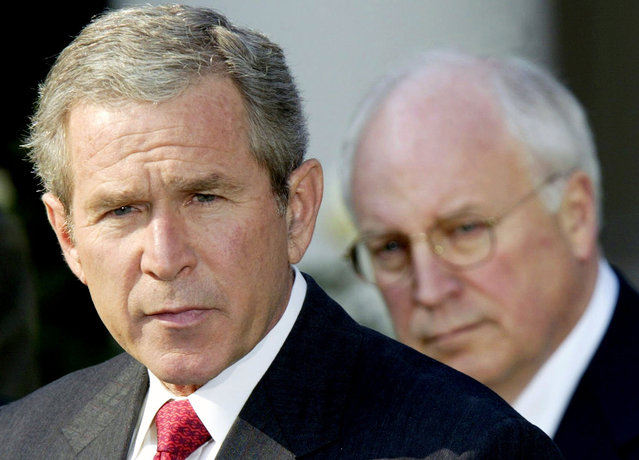
U.S. President George W. Bush, watched by Vice President Dick Cheney, speaks before signing a $355 billion military spending bill in the Rose Garden of the White House October 23, 2002. The bill gave the Pentagon a nearly $40 billion boost as it prepared for possible war with Iraq, the White House said. (Photo by Kevin Lamarque/Reuters via The Atlantic)
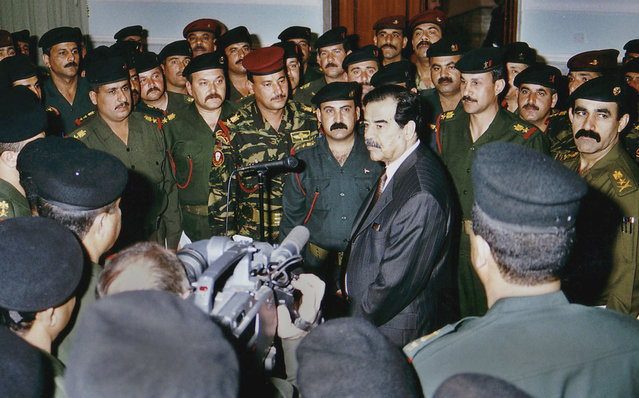
Iraqi President Saddam Hussein, center, talks with elite Republican Guard officers in Baghdad, on March 1, 2003. Iraq began destroying its Al Samoud 2 missiles Saturday as ordered by the United Nations and agreed with weapons inspectors on a timetable to dismantle the entire missile program, U.N. and Iraqi officials said. (Photo by AP Photo/INA via The Atlantic)
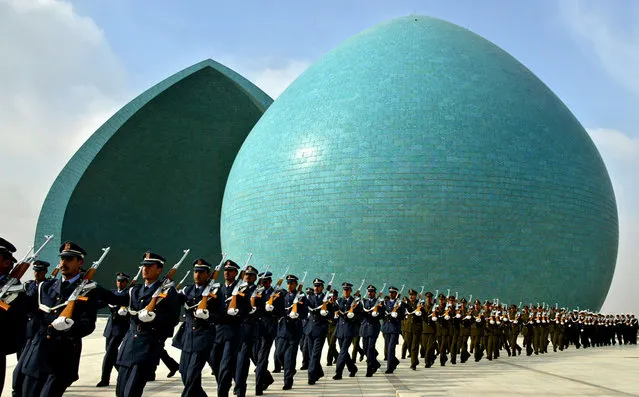
Iraqi soldiers march in the courtyard of the Martyrs Monument in Baghdad, on February 16, 2003. (Photo by Suhaib Salem/Reuters via The Atlantic)
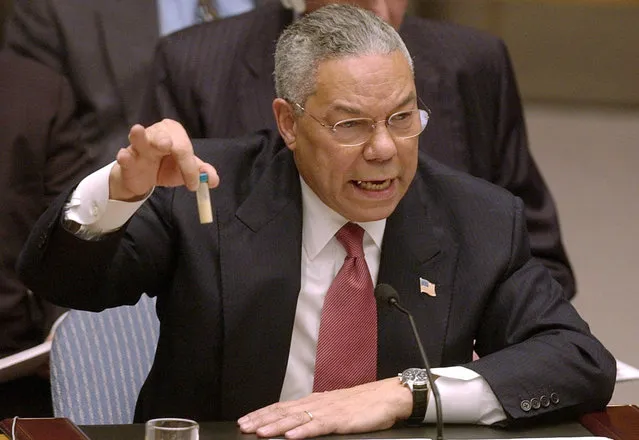
Secretary of State Colin Powell holds up a vial he said could contain anthrax as he presents evidence of Iraq's alleged weapons programs to the United Nations Security Council in this February 5, 2003 photo. (Photo by Elise Amendola/AP Photo via The Atlantic)
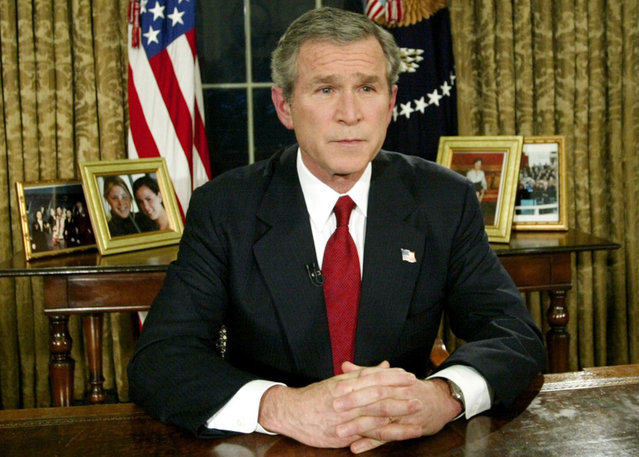
U.S. President George W. Bush announced the start of war between the United States and Iraq during a televised address from the Oval Office, on March 19, 2003. The United States said it had began its war against Iraq just minutes after several explosions were heard over Baghdad. (Photo by Kevin Lamarque/Reuters via The Atlantic)
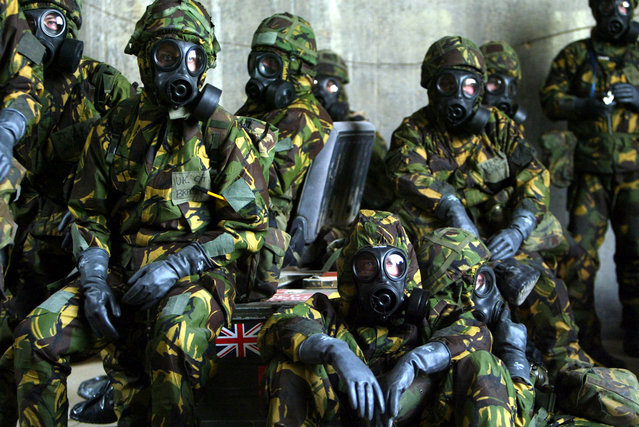
British Royal Air Force personnel wait in a bunker wearing full Nuclear Biological and Chemical suits after a warning of a Scud missile attack on their base in Kuwait March 20, 2003. (Photo by Russell Boyce/Reuters via The Atlantic)
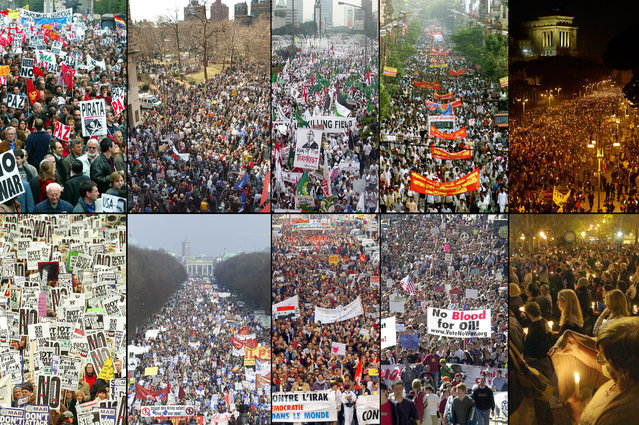
Protests against war in Iraq erupted around the world in March of 2003. This combination photo shows (from top left) large demonstrations in Madrid, New York, Jakarta, Calcutta, Rome, (2nd row) London, Berlin, Marseille, San Francisco, and Montevideo. (Photo by , in same order: Reuters, AP Photo/Louis Lanzano, Reuters/Pipit Prahara, Reuters/Sucheta Das, Reuters/Giampiero Sposito, Reuters/Peter Macdiarmid, AP Photo/Franka Bruns, AP Photo/Claude Paris, AP Photo/Noah Berger, and AP Photo/Marcelo Hernandez via The Atlantic)
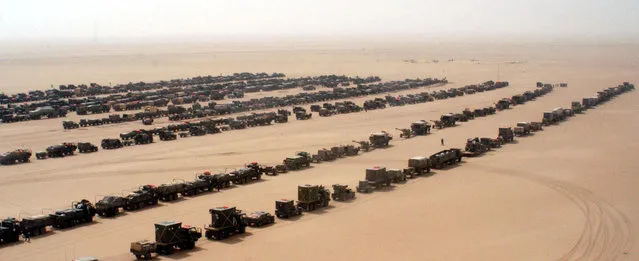
An assault convoy of trucks and armored vehicles of the 101st Airborne Division's 3rd Brigade Combat Team prepare to cross into Iraq, on March 21, 2003. (Photo by Robert Woodward/Reuters/US Army via The Atlantic)
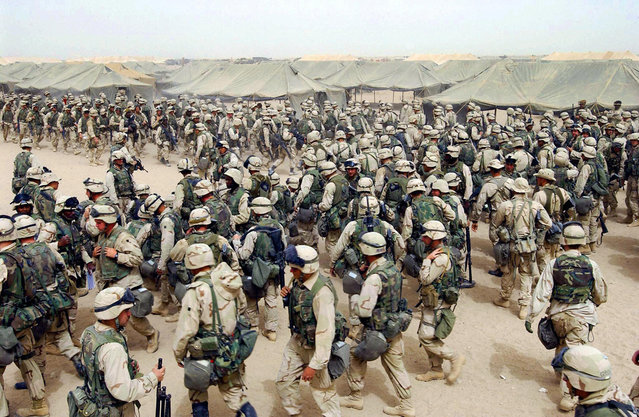
US Marines from the 2nd battalion/8 MAR, prepare themselves after receiving orders to cross the Iraqi border at Camp Shoup, northern Kuwait, on March 20, 2003. (Photo by Eric Feferberg/AFP Photo via The Atlantic)
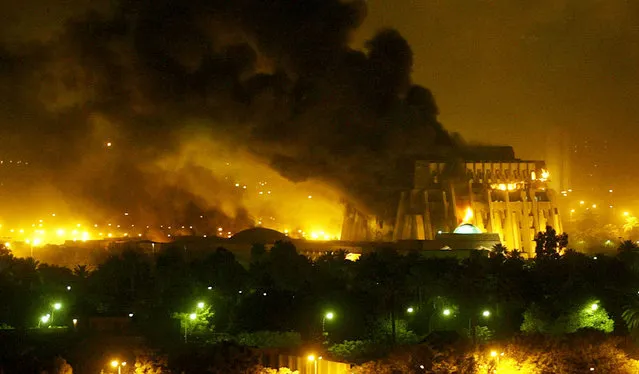
An explosion rocks Baghdad during air strikes on March 21, 2003. The attacks far exceeded strikes that launched the war the previous day, Reuters correspondents said. (Photo by Goran Tomasevic/Reuters via The Atlantic)
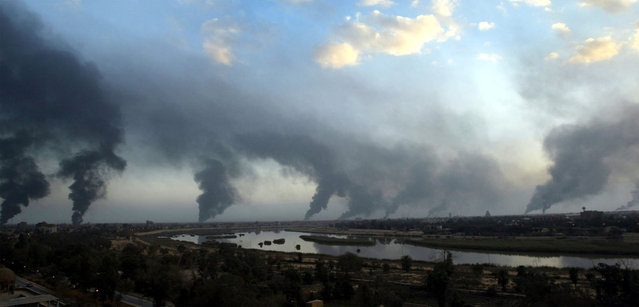
Palls of black smoke from raging oil fires billow over Baghdad, on March 27, 2003. The oil-filled trenches were set off by Iraqis to try and block the visibility of U.S. warplanes and missiles. (Photo by Goran Tomasevic/Reuters via The Atlantic)
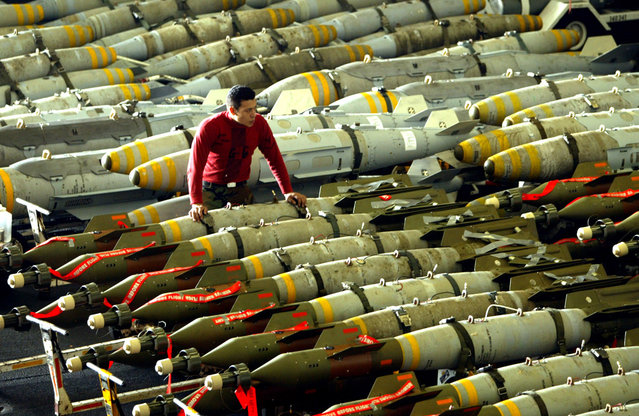
An aviation ordnance man observes rows of bombs on the hangar bay of the USS Kitty Hawk aircraft carrier in the northern Gulf, on March 30, 2003. The carriers airwing flew 104 total sorties over Iraq on March 29, and dropped bombs on targets including air defense sites, a train loaded with tanks and a surface-to-air missile site. (Photo by Paul Hanna/Reuters via The Atlantic)
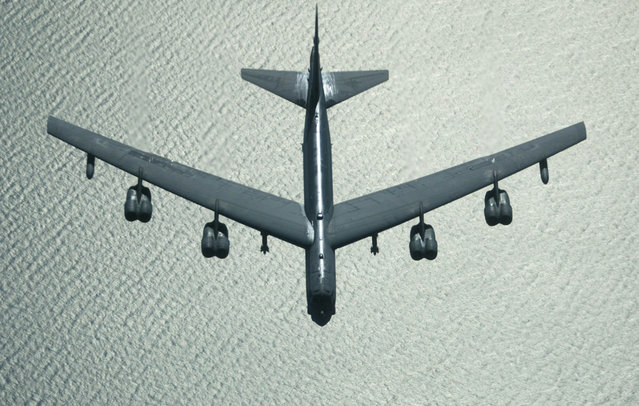
A U.S. Air Force B-52 bomber returns from a mission over Iraq, after refueling from a KC-10 plane over the Black Sea, on March 28, 2003. (Photo by Jockel Finck/AP Photo via The Atlantic)
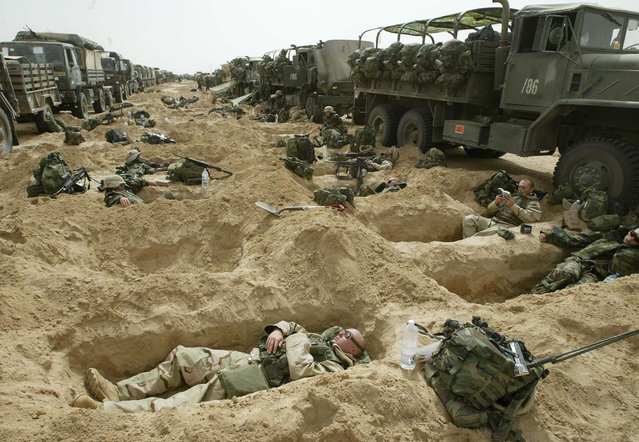
Soldiers from the 3rd Brigade of the U.S. 101st Airborne Division rest in foxholes by their convoy in a staging area in the Kuwaiti desert, on, March 21, 2003. (Photo by Jean-Marc Bouju/AP Photo via The Atlantic)
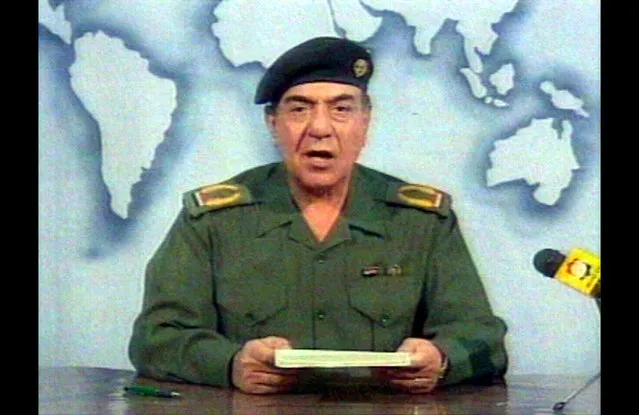
Iraqi Information Minister Mohammed Saeed al-Sahaf reads a message to the Iraqi people from President Saddam Hussein broadcast on Iraqi television, April 1, 2003. In the message Saddam said that jihad was a religious duty and he urged the Iraqi people to fight invading U.S. and British troops wherever they found them. (Photo by Reuters/Iraqi television via The Atlantic)
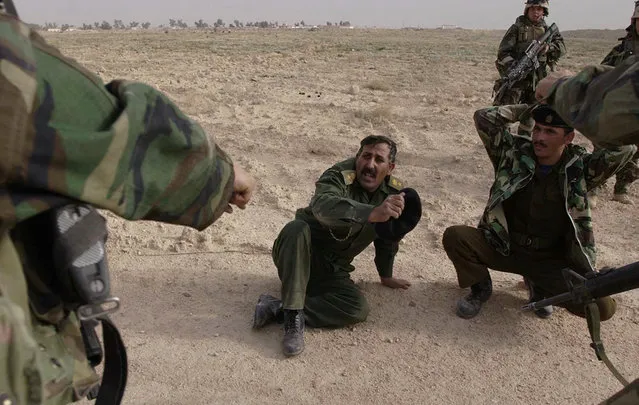
An Iraqi officer is held by US Marines with India Company 3rd Battalion, 7th Marines, 1st Marine Division following a gunfight at the headquarters of the Iraqi 51st and 32nd mechanized infantry divisions near Az Bayer, Iraq on March 21, 2003. (Photo by Laura Rauch/AP Photo via The Atlantic)
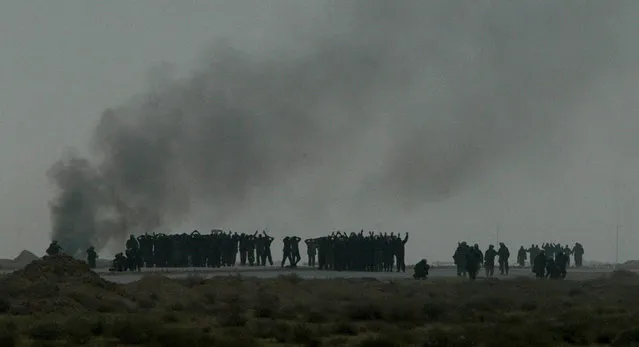
Iraqi soldiers stand together with their arms raised, silhouetted against a sky covered with black smoke as they surrender to U.S. Marines from the 15th Marine Expeditionary Unit in southern Iraq, on March 21, 2003. (Photo by Itsuo Inouye/AP Photo via The Atlantic)
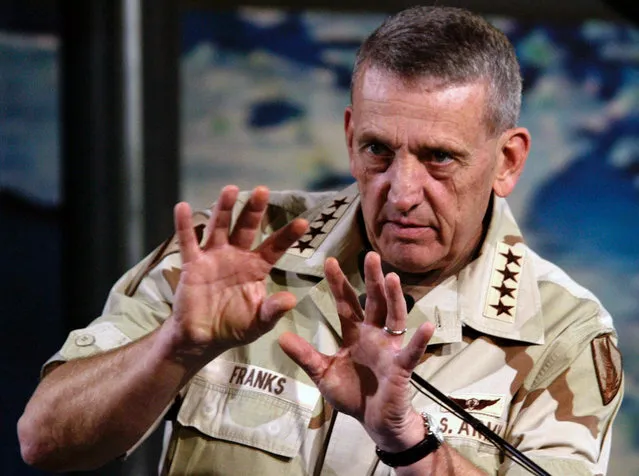
Coalition forces commander U.S. Army General Tommy Franks tells reporters that the military campaign is on track during a press conference in the media center at Camp As Sayliyah, outside Doha, Qatar, on March 30, 2003. (Photo by Tim Aubry/Reuters via The Atlantic)
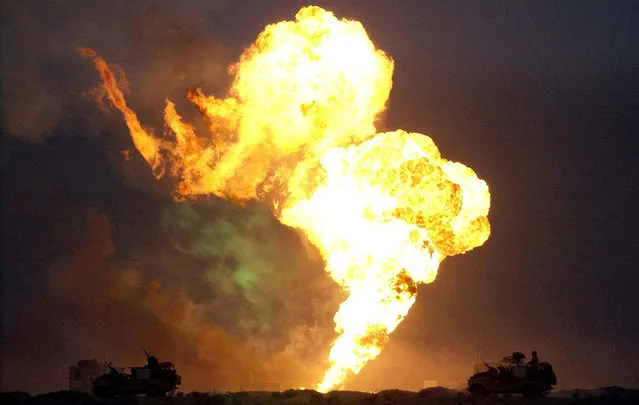
British Household Cavalry Scimitar tanks drive past burning oil wells in Southern Iraq, on March 20, 2003. (Photo by Reuters)
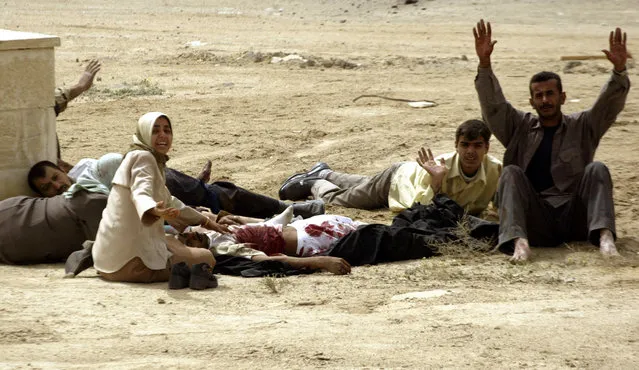
Iraqi civilians scream for help as they are caught in the crossfire while marines from the U.S. Marine Expeditionary Unit Fox Company “Raiders” push into southern Iraq to take control of the main port of Umm Qasr on March 21, 2003. (Photo by Desmond Boylan/Reuters via The Atlantic)
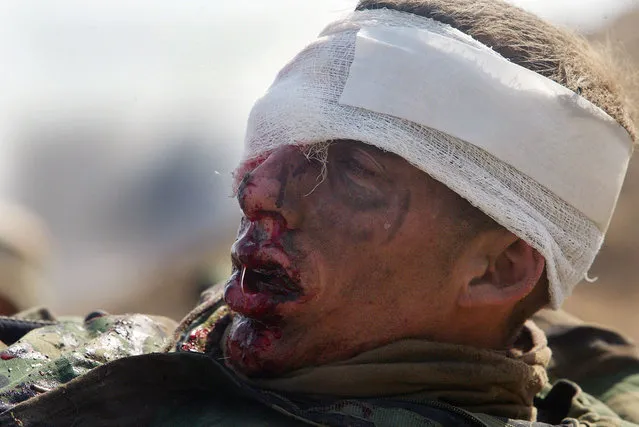
U.S. Marine Lt. Ben Reid from 1/2 Charlie Company of Task Force Tarawa waits to be medivaced after being hit with shrapnel and a machine gun round, in the southern Iraqi city of Nasiriyah, on March 23, 2003. The Marines suffered a number of deaths and casualties during gun battles throughout the city. (Photo by Joe Raedle via The Atlantic)
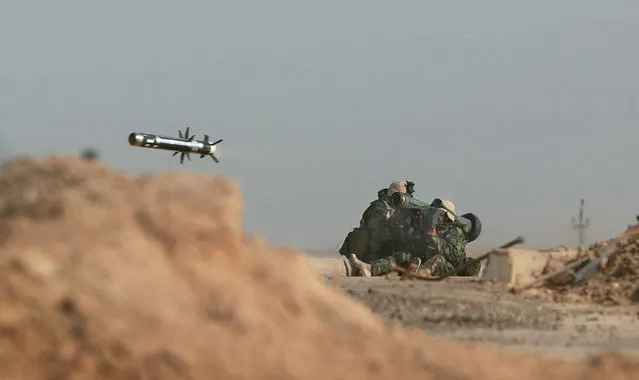
U.S. Marines from the 15 Marine Expeditionary Unit fire a shoulder-launched Javelin missile during a battle with Iraqi troops at the port in Umm Qasr, Iraq, on March 23, 2003. (Photo by Simon Walker/AP Photo/The London Times via The Atlantic)
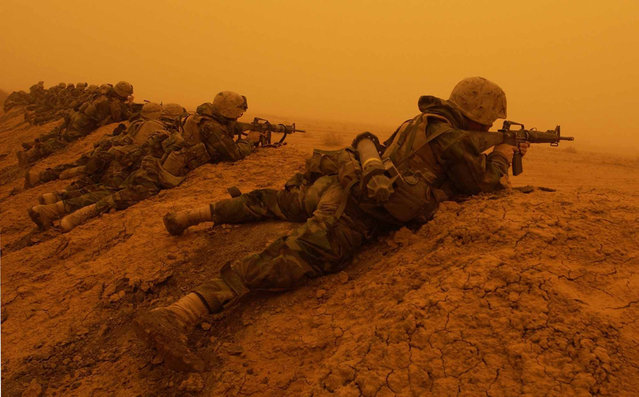
U.S. Marines with 3rd Battalion, 7th Marines, 1st Marine Division, return fire after coming upon a mortar attack during an orange sandstorm on a road south of Baghdad, on March 26, 2003. (Photo by Laura Rauch/AP Photo via The Atlantic)
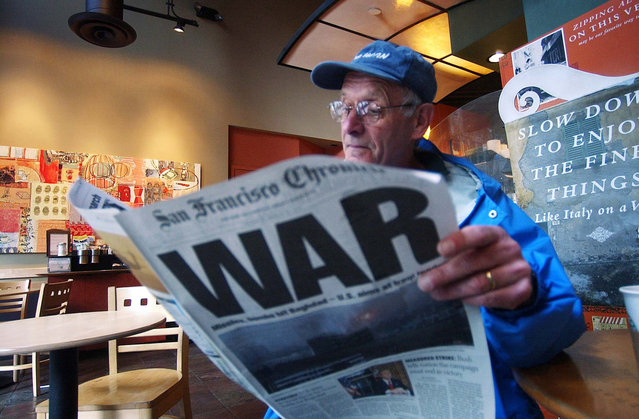
Ray Jacques reads the San Francisco Chronicle's war special section inside a Starbucks coffee shop in San Francisco, in this March 20, 2003 photo. (Photo by Marcio Jose Sanchez/AP Photo via The Atlantic)
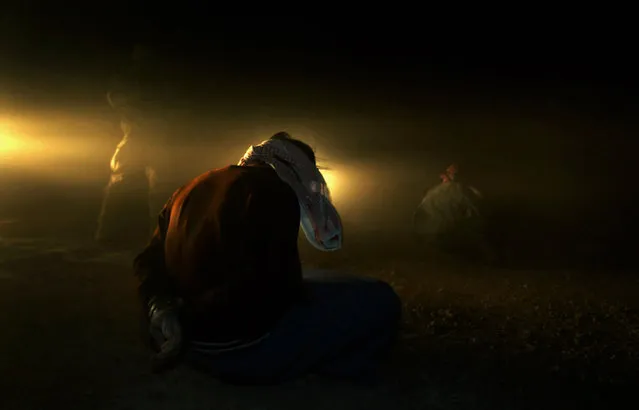
Lit by Hummvee headlights, a soldier from the 3rd Brigade of the 101st Airborne Division guards Iraqis who were intercepted during dust storm on the perimeter of the division's forward base in south Central Iraq, on March 26, 2003. (Photo by Jean-Marc Bouju/AP Photo via The Atlantic)
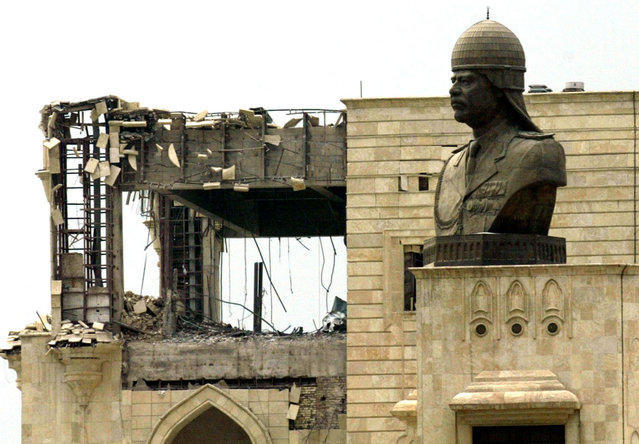
A statue of Iraqi President Saddam Hussein, at his palace, damaged during a U.S. led air strike in Baghdad, on March 23, 2003. (Photo by Faleh Kheiber/Reuters via The Atlantic)
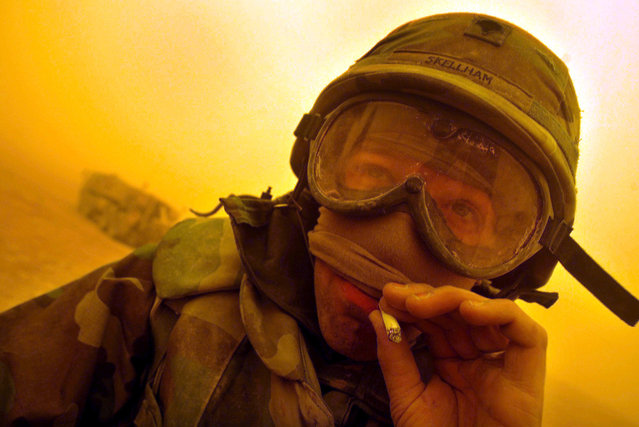
A U.S. Army combat engineer enjoys a cigarette as he relaxes between the cities of Najaf and Karbala as another sandstorm turned the daylight orange, on March 26, 2003. (Photo by Kai Pfaffenbach/Reuters via The Atlantic)
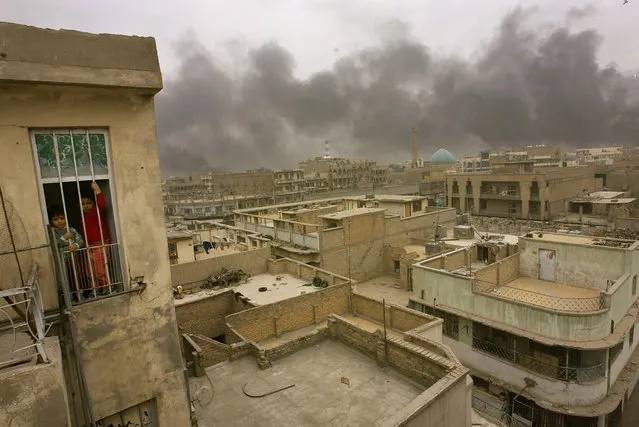
Two Iraqi children look through their window in New Baghdad, a suburb of Baghdad, on March 24, 2003. Oil fires burned across the city as a defense against incoming US missiles and bombs. (Photo by Jerome Delay/AP Photo via The Atlantic)
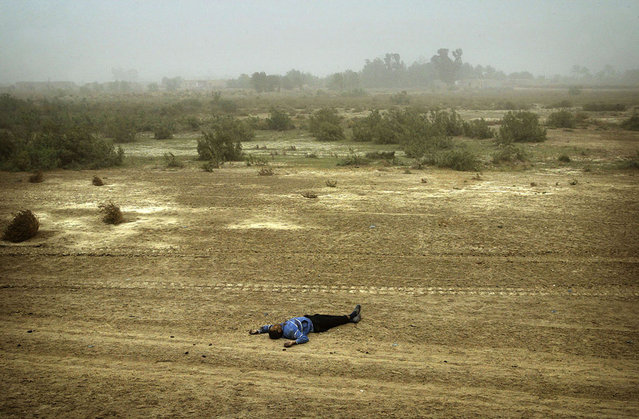
A body of Iraqi man lies by the road side north of Al Nassiriyah, on March 25, 2003. More than 30 men of military age were killed on the key northern highway by an apparent U.S. air strike on the vehicles carrying the Iraqis. (Photo by Damir Sagolj/Reuters via The Atlantic)
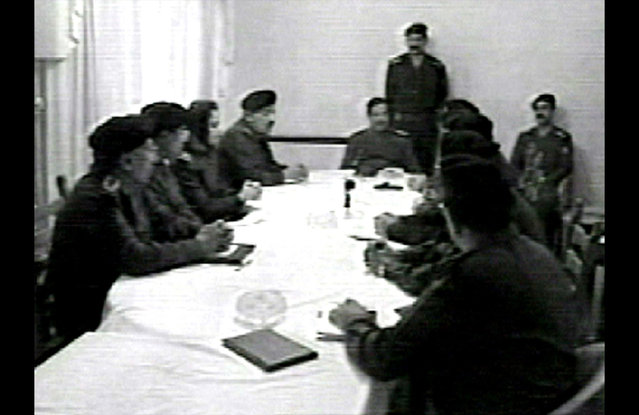
In this image from video seen on Iraqi television on March 27, 2003, Iraqi President Saddam Hussein meets with high-ranking Ba'ath party officials. (Photo by AP Photo/Iraqi TV/APTN via The Atlantic)
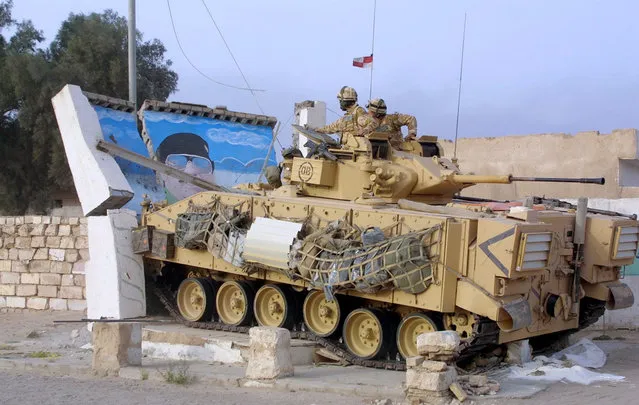
A British Warrior armored combat vehicle knocks over a picture of Saddam Hussein in the city of Basra, in southern Iraq, on March 24, 2003. (Photo by Mark Richards/Reuters via The Atlantic)
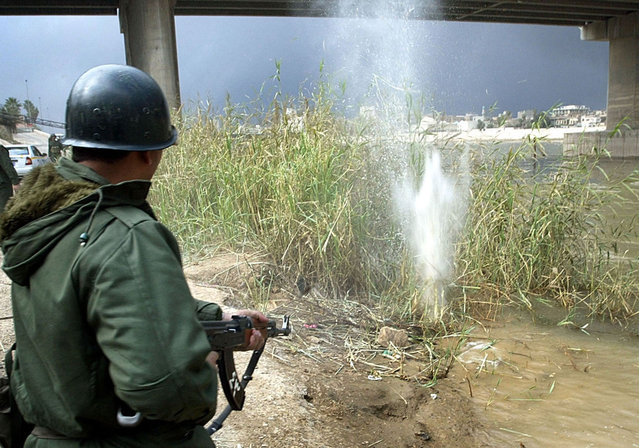
An Iraqi soldier fires his AK-47 rifle into reeds on the banks of the Tigris river in Baghdad, on March 23, 2003 after reports that U.S. or British pilots may have ejected over the city. Television reports showed Iraqi soldiers shooting into the Tigris river and in boats, apparently searching the water for pilots. (Photo by Goran Tomasevic/Reuters via The Atlantic)
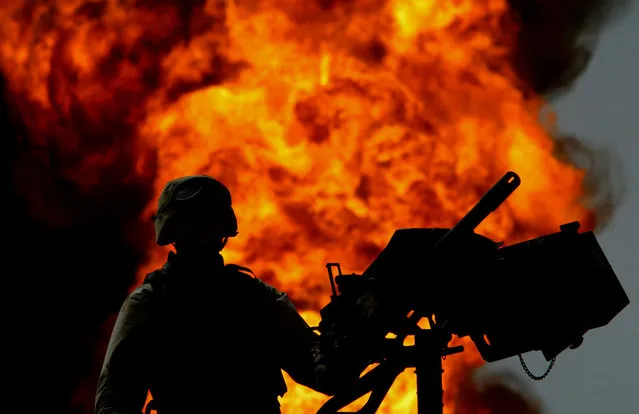
A U.S. Army soldier atop a Humvee armed with a heavy machine gun secures an area by a burning oil well in Iraq's vast southern Rumaila oilfields, on March 30, 2003. U.S. engineers moved through the oilfields on Sunday shutting down wellheads in an operation that could take months to complete. (Photo by Yannis Behrakis/Reuters via The Atlantic)
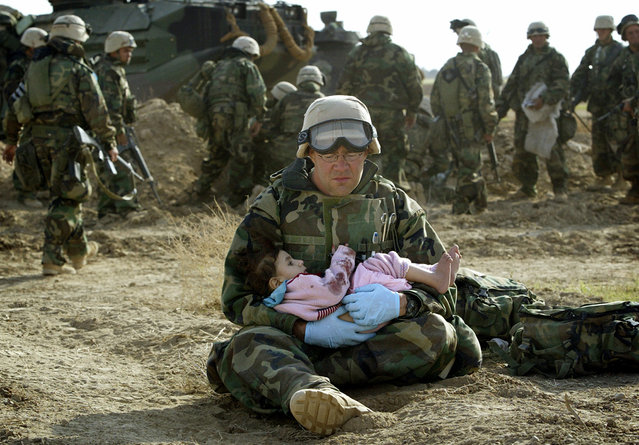
U.S. Navy Hospital Corpsman HM1 Richard Barnett, assigned to the 1st Marine Division, holds an Iraqi child in central Iraq, on March 29, 2003. Confused front line crossfire ripped apart an Iraqi family after local soldiers appeared to force civilians towards positions held by U.S. Marines. (Photo by Damir Sagolj/Reuters via The Atlantic)
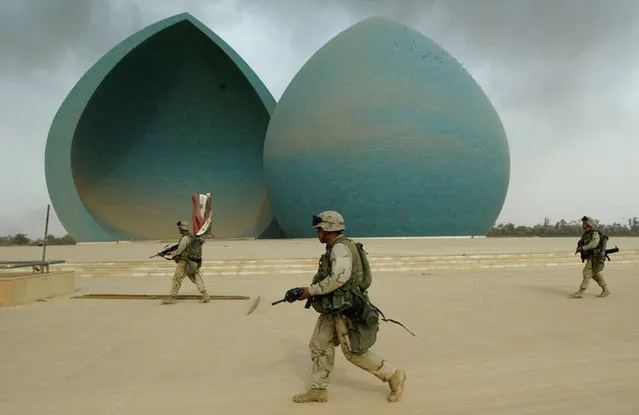
U.S. Marines from Lima Company, a part of a 7-th Marine Regiment, walk in front of the Martyrs Monument, during an operation to secure securing the center of Baghdad on April 9, 2003. (Photo by Oleg Popov/Reuters via The Atlantic)
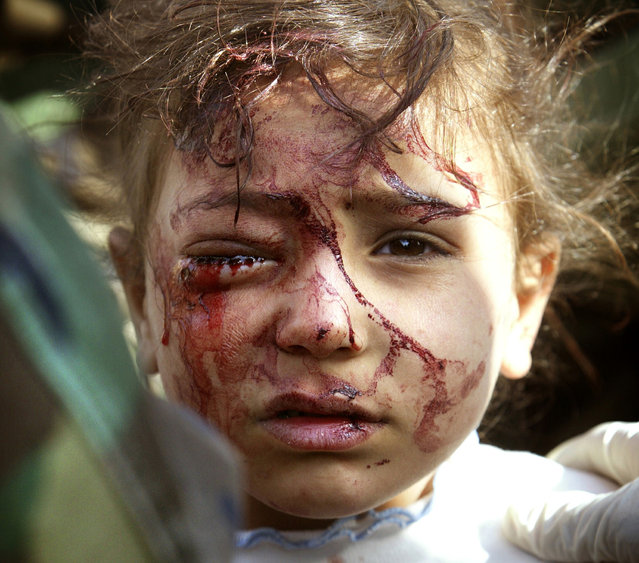
A wounded Iraqi girl is treated by U.S. marines in central Iraq, on March 29, 2003. The four-year old girl, blood streaming from an eye wound, was screaming for her dead mother, while her father, shot in a leg, begged to be freed from the plastic wrist cuffs slapped on him by U.S. marines, so he could hug his other terrified daughter. (Photo by Damir Sagolj/Reuters via The Atlantic)
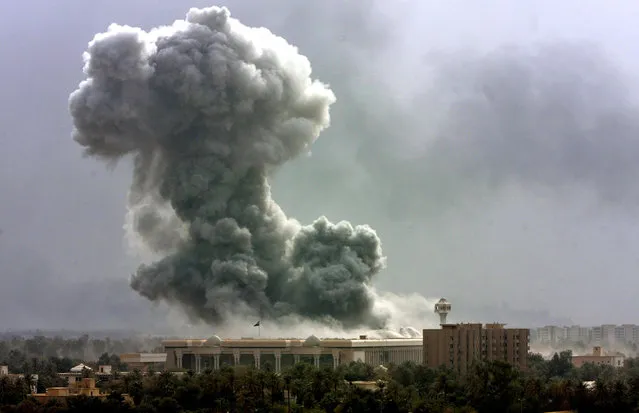
Smoke billows from a building hit during coalition forces air raid in Baghdad, on Monday March 31, 2003. (Photo by Jerome Delay/AP Photo via The Atlantic)
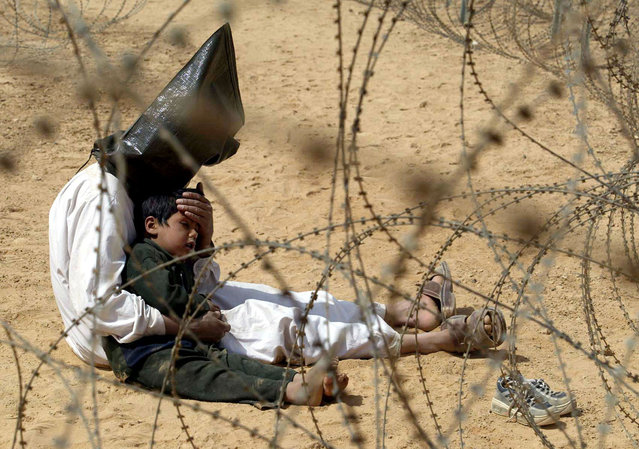
An Iraqi man comforts his 4-year-old son at a regroupment center for POWs of the 101st Airborne Division near An Najaf, Iraq in this March 31, 2003 photo. The man was seized in An Najaf with his son and the U.S. military did not want to separate father and son. (Photo by Jean-Marc Bouju/AP Photo via The Atlantic)
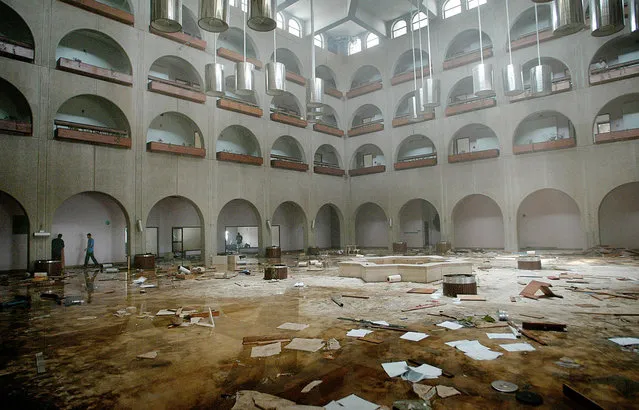
The inside of the Sheraton Hotel, scene of alleged looting, in Basra, southern Iraq, on April 8, 2003. (Photo by Simon Walker/Reuters via The Atlantic)
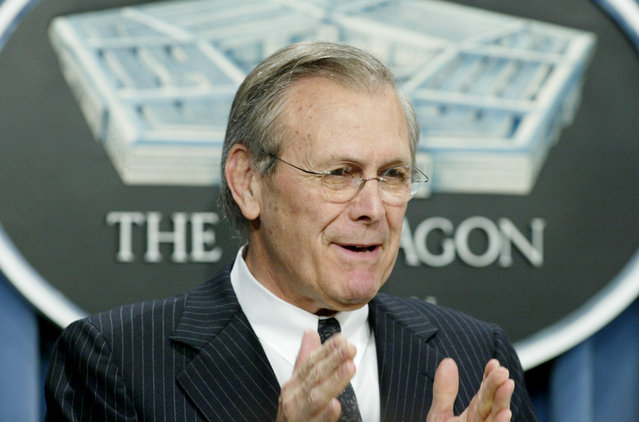
U.S. Defense Secretary Donald Rumsfeld speaks to the press at a Pentagon briefing in Washington, April 9, 2003. Rumsfeld praised the progress of American-led forces fighting in Iraq but warned the fighting would continue and the military still needed to account for Iraqi President Saddam Hussein. (Photo by Rick Wilking/Reuters via The Atlantic)
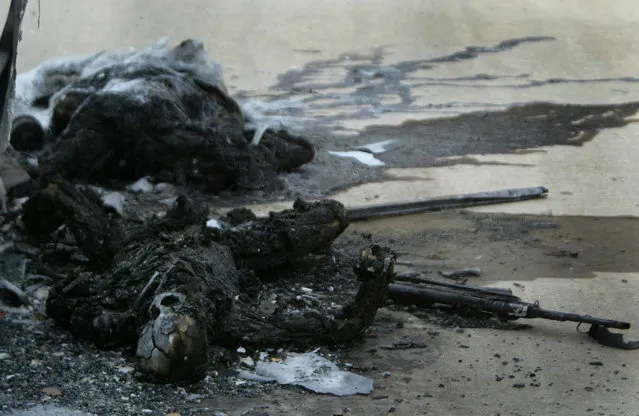
The charred remains of dead Iraqi soldiers lay outside a bus hit by a U.S. tank shell on a highway between Baghdad's international airport and the city center, on April 7, 2003. (Photo by Kai Pfaffenbach/Reuters via The Atlantic)
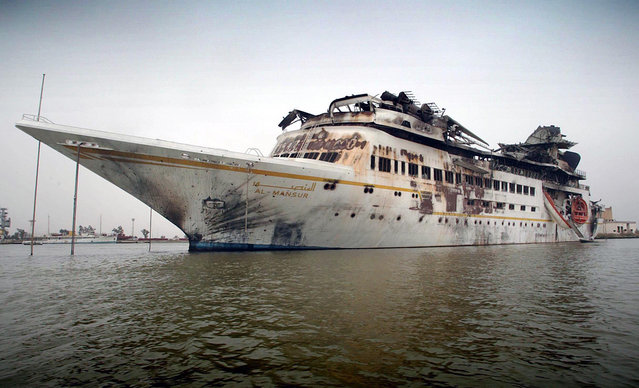
The damaged “Al Mansur”, Iraqi President Saddam Hussein's private yacht, anchored in central Basra, on April 10, 2003. (Photo by Simon Walker/Reuters via The Atlantic)
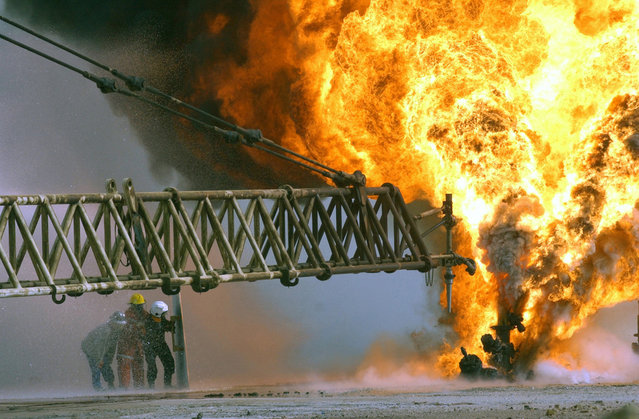
Kuwaiti firefighters secure a burning oil well in the Rumaila oilfields, on March 27, 2003, set ablaze by Iraqi military forces. (Photo by Mary Rose Xenikakis/USMC via The Atlantic)
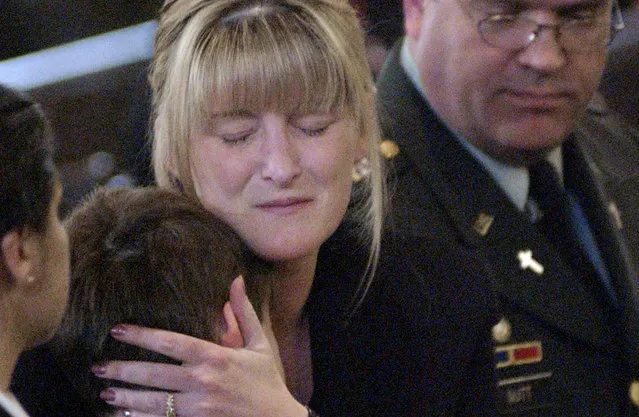
Six-year-old Tyler Jordan is hugged by his mother Amanda while U.S. Army Chaplain Captain David Nott looks on during the funeral of the boy's father, United States Marine Gunnery Sgt. Philip Jordan, at Holy Family Church in Enfield, Connecticut, on April 2, 2003. Sgt. Jordan was killed during fighting outside Nasiriyah on March 23 in the early days of the U.S. led invasion of Iraq. (Photo by Chip East/Reuters via The Atlantic)
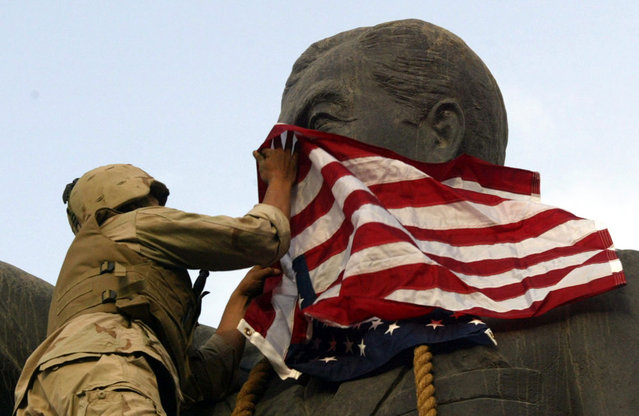
A U.S. Marine covers the face of a statue of Iraqi President Saddam Hussein with a U.S. flag in Baghdad, on April 9, 2003. U.S. troops briefly draped an American flag over the face of a giant statue of Hussein, as they prepared to topple it in front of a crowd of Iraqis. (Photo by Goran Tomasevic/Reuters via The Atlantic)
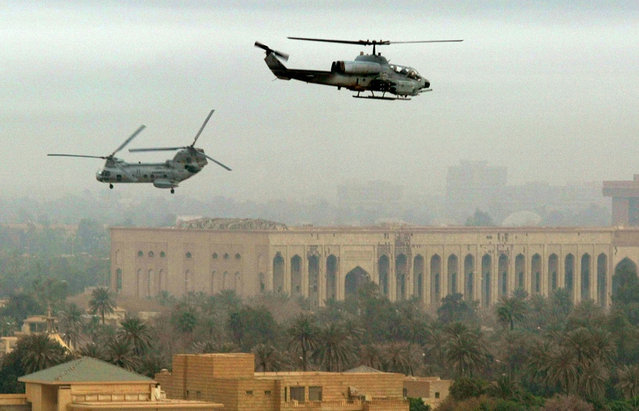
U.S. Marine helicopters patrol the skies over Baghdad, on April 13, 2003. (Photo by Gleb Garanich/Reuters via The Atlantic)
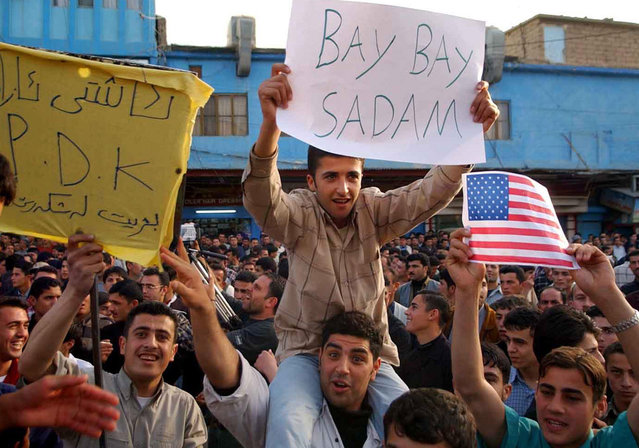
Iraqi Kurds wave banners and U.S. and British flags in the northern Iraqi town of Dohuk, on April 9, 2003, to celebrate the arrival of U.S. led coalition forces' in Baghdad. Iraqi Kurds shouted for joy and fired in the air on Wednesday after U.S. forces entered Baghdad. “It's all over in Baghdad”, said 29-year-old Rafiq Baway, who heard the news on satellite TV in the city of Sulaimaniya. He believed it would lead to the fall of Kirkuk, the northern oil hub where Kurds accuse Saddam of expelling Kurdish inhabitants and replacing them with Arabs. (Photo by Reuters via The Atlantic)
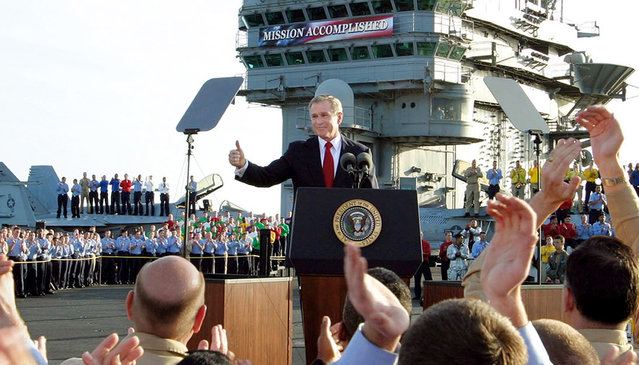
President Bush gives a thumbs-up sign after declaring the end of major combat in Iraq as he speaks aboard the aircraft carrier USS Abraham Lincoln off the California coast, on May 1, 2003. (Photo by J. Scott Applewhite/AP Photo via The Atlantic)
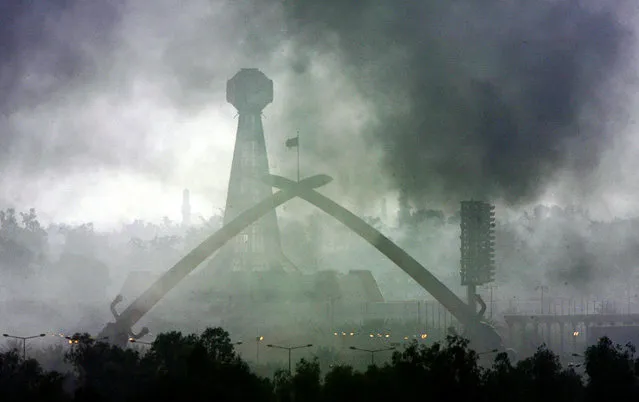
Smoke from burning oil fires set ablaze by Iraqis as a shield against incoming missiles and air raids obscures Baghdad, on April 1, 2003. (Photo by Jerome Delay/AP Photo via The Atlantic)
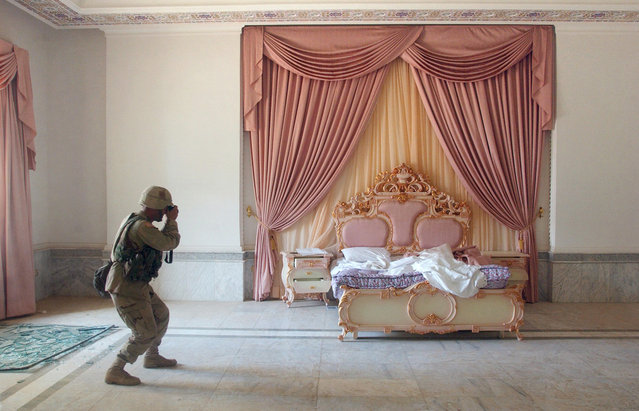
US Army Sergeant Craig Zentkovich from Connecticut belonging to the 1st Brigade Combat Team photographs a pink bedroom at Saddam Hussein's presidential palace, on April 13, 2003. (Photo by Romeo Gacad/AFP Photo via The Atlantic)
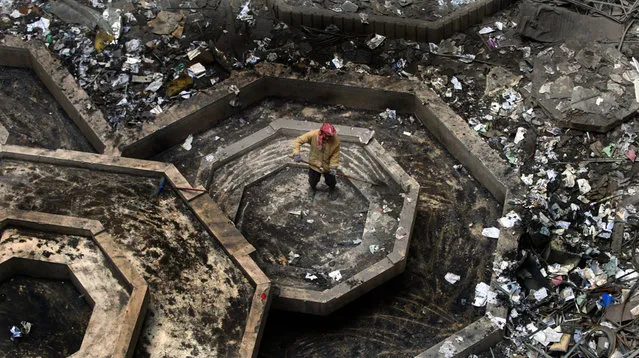
A construction worker removes debris from inside the destroyed Education building December 11, 2003 in Baghdad, Iraq. (Photo by Joe Raedle via The Atlantic)
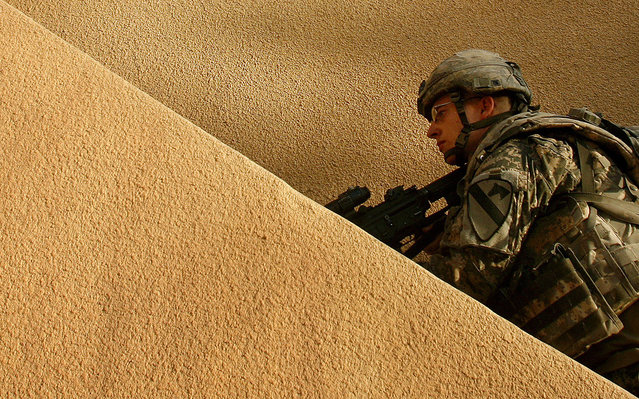
U.S. Army Pvt. Joe Armstrong of Alpha Company, 1st Battalion, 5th Cavalry Regiment, 2nd Brigade, 1st Cavalry Division searches the rooftop of a house during an operation in the Amariyah neighborhood of west Baghdad, Iraq, on Monday, August 13, 2007. (Photo by Petr David Josek/AP Photo via The Atlantic)
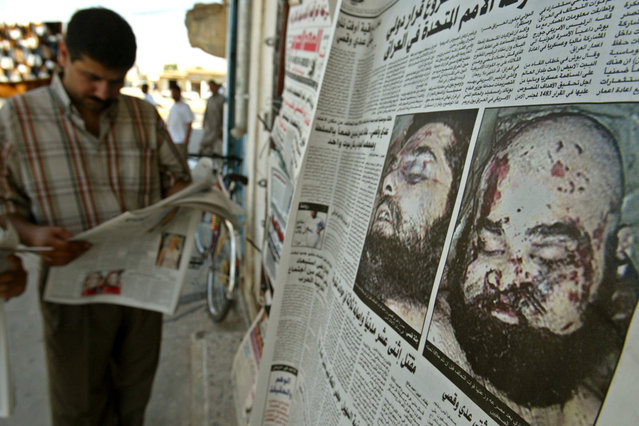
A man reads an Iraqi newspaper in the northern town of Tikrit after morgue photos of Saddam Hussein's sons Uday and Qusay were published for the first time, on July 26, 2003. Hoping to convince Iraqis that the two men were dead, the U.S. military released photos of the pair on Thursday and allowed a small group of media to view the bodies. (Photo by Faleh Kheiber/Reuters via The Atlantic)

Wrecks of Iraqi military vehicles lie in a dump on the outskirts of Baghdad, on May 25, 2003. The vehicles brought here were destroyed when U.S.-led strikes used depleted uranium shells against tanks and other armored vehicles during the war that ousted Saddam Hussein. Iraqi doctors and scientists are worried that birth defects and childhood cancers could surge in the aftermath of the latest conflict, not unlike medical problems in southern Iraq after the mildly radioactive munitions were first used in the 1991 Gulf War. (Photo by Jamal Saidi/Reuters via The Atlantic)
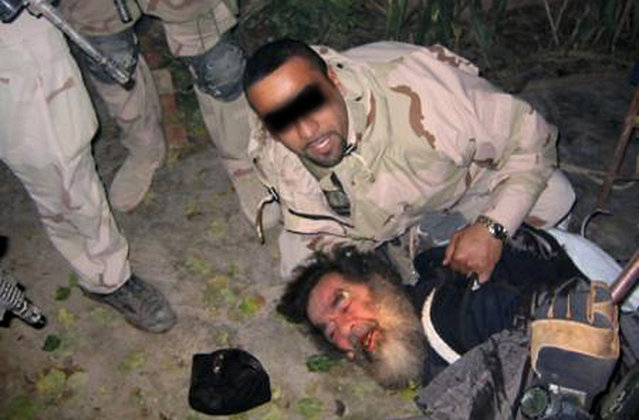
This unsourced picture shows ousted Iraqi leader Saddam Hussein being dragged from hiding following his capture by US troops, on December 13, 2003 in an underground hole at a farm in the village of ad-Dawr, near his hometown of Tikrit in northern Iraq. The picture is one of a series of images of the deposed dictator unauthorized for release by the US army that has been circulating in recent days on the internet. The man holding him was later identified as an Iraqi-American named Samir, who was the translator for the U.S. Special Forces that helped find Hussein. (Photo by AFP Photo via The Atlantic)
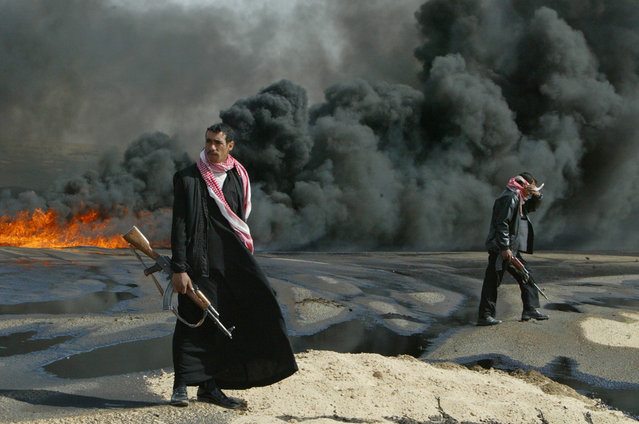
Iraqi policemen guard a sabotaged burning pipeline near the city of Kerbala, on February 23, 2004. (Photo by Faleh Kheiber/Reuters via The Atlantic)
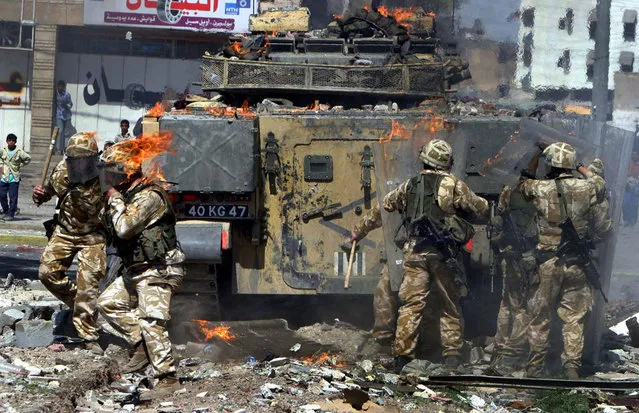
British soldiers come under attack in the southern Iraqi town of Basra, on Monday March 22 2004, during a protest by unemployed Iraqi civilians who failed to get jobs with the local customs office, and also condemned the assassination of Hamas founder Ahmed Yassin in Gaza City earlier in the day. (Photo by Nabil al-Jurani/AP Photo via The Atlantic)
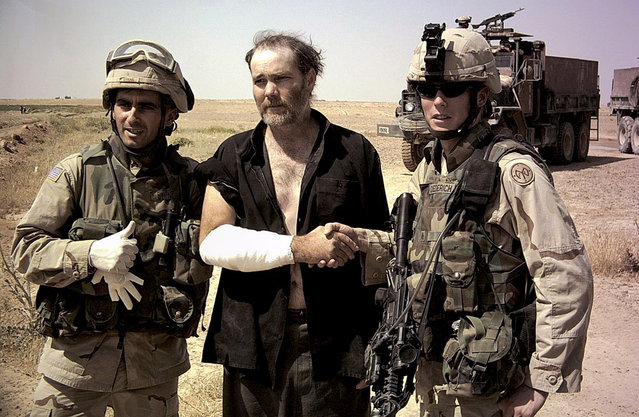
Former hostage Thomas Hamill, center, is seen with two U.S. Army soldiers, shortly after his escape south of Tikrit, in this picture released on Monday, May 3, 2004. Hamill, who escaped from captivity during the weekend, left Iraq and stopped by a military hospital in Germany for a check-up, a U.S. military official said. (Photo by AP Photo/U.S Army via The Atlantic)
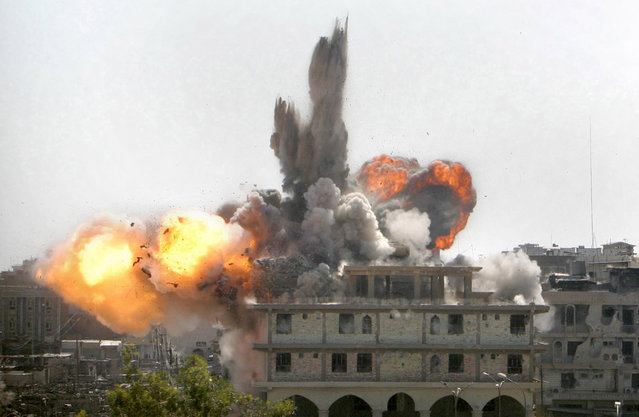
A building explodes as the first bomb drops during a U.S. aerial assault on insurgent targets in Najaf, Iraq, on August 19, 2004. (Photo by Jim MacMillan/AP Photo via The Atlantic)
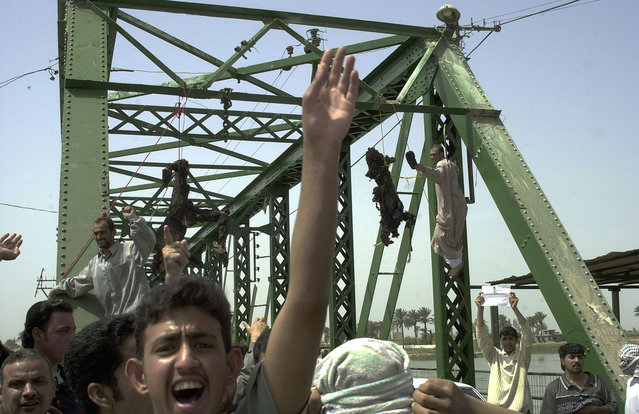
In this March 31, 2004 photo, Iraqis chant anti-American slogans as charred bodies hang from a bridge over the Euphrates River in Fallujah, west of Baghdad. A convoy containing four American contractors from the private military company Blackwater USA had been ambushed, all four inside were killed. (Photo by Khalid Mohammed/AP Photo via The Atlantic)
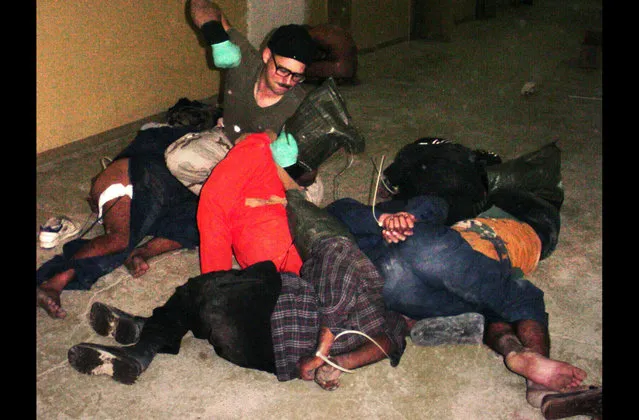
In this undated photo, Charles Graner, a U.S. Army reservist appears poised to punch a Iraqi detainee at Abu Ghraib Prison as other detainees lay bound at the hands and hooded. Detainee at right appears to be partially clothed. Outrage among Iraqis and much of the world erupted as photographic evidence surfaced of torture and abuse inside the prison in 2004. (Photo courtesy of Washington Post via The Atlantic)
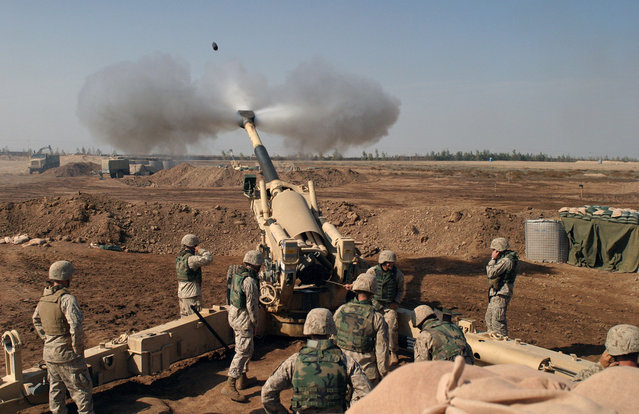
A Howitzer gun crew of 4th Battalion, 14th Marines, Mike Battery, Gun 4, engage enemy targets during the Second Battle of Fallujah, on November 11, 2004. (Photo by Lance Corporal Samantha L. Jones/USMC via The Atlantic)
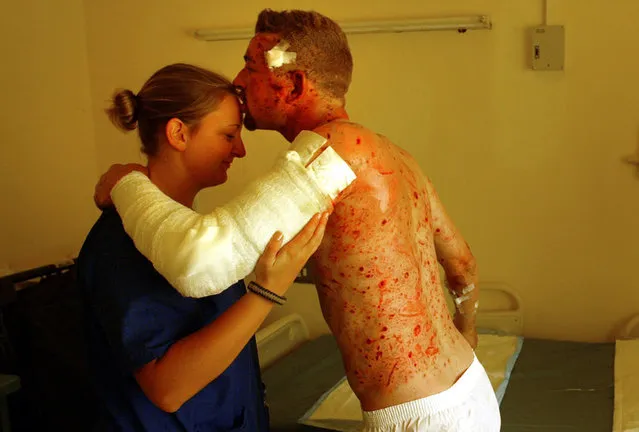
British private contractor Michael Fitzpatrick thanks his U.S. Army nurse Jayme Sells while recovering from a suicide bomb attack in an American military hospital in Baghdad, on October 15, 2004. Fitzpatrick said that he was drinking coffee in the Green Zone Cafe Thursday when a suicide bomber detonated in one of two explosions that killed 6 people and wounded many more. (Photo by John Moore/AP Photo via The Atlantic)
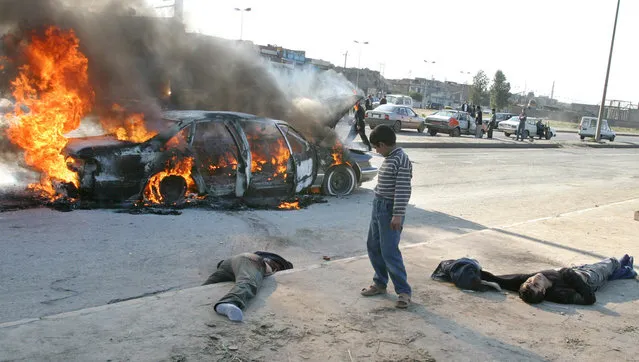
An Iraqi boy looks at the bodies of four men laying next to their burning car after they were attacked by gunmen in the northern Iraq city of Mosul, on December 17, 2004. Insurgents attacked a car carrying at least three Westerners, killing them and their Iraqi driver, and chopping off the head of one victim, local witnesses said. (Photo by Namir Noor-Eldeen/Reuters via The Atlantic)
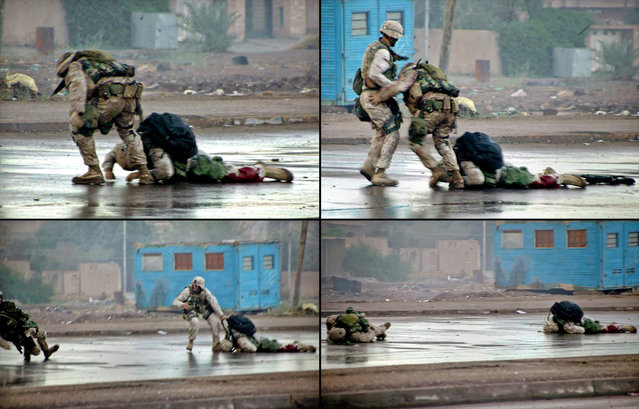
Combination handout pictures released on December 17, 2004, (upper left) U.S. Marine Platoon Gunnery Sergeant Ryan P. Shane, from the 1st Battalion of the 8th Marine Regiment pulls a fatally wounded comrade to safety while under fire during a military operation in Fallujah. (upper right) Shane and another member of 1/8 pulled their fatally wounded comrade under fire. (lower left) Shane (left) is hit by insurgent fire and (lower right) lies wounded. (Photo by Cpl. Joel A. Chaverri/Reuters/USMC via The Atlantic)
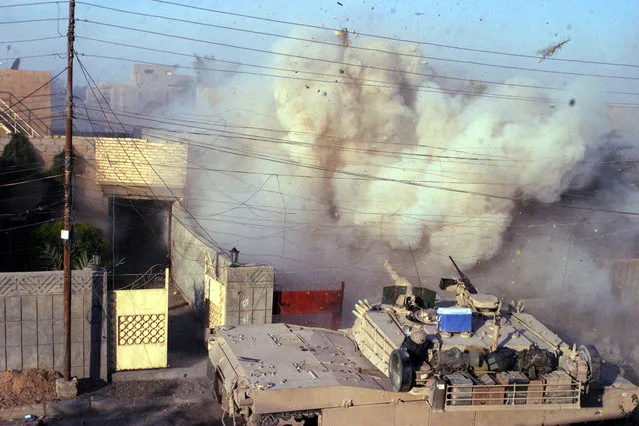
An M1A1 Abrams tank with the 2nd Tank Battalion returns fires into a building after U.S. Marines came under attack in Fallujah, in this December 16, 2004 photo. (Photo by Lance Corporal James J. Vooris/Reuters/USMC via The Atlantic)
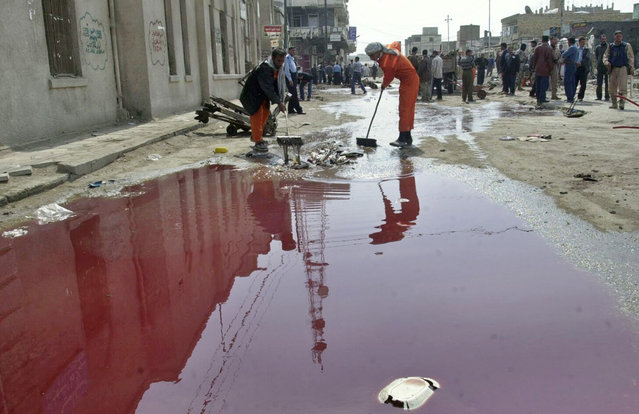
Iraqi workers clean debris near a large pool of blood at the scene of a suicide attack in the city of Hilla, on February 28, 2005. A suicide bomber detonated a car near police recruits and a crowded market, killing 115 people. (Photo by Ali Abu Shish/Reuters via The Atlantic)
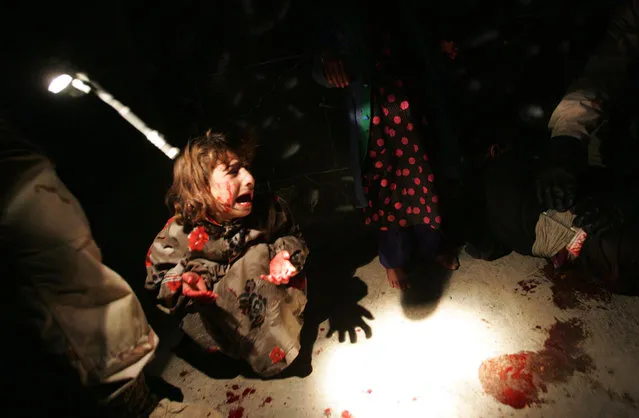
Samar Hassan screams after her parents were killed by U.S. Soldiers with the 25th Infantry Division in a shooting January 18, 2005 in Tal Afar, Iraq. The troops fired on the Hassan family car when it unwittingly approached them during a dusk patrol in the tense northern Iraqi town. Parents Hussein and Camila Hassan were killed instantly, and a son Rakan, 11, was seriously wounded in the abdomen. (Photo by Chris Hondros via The Atlantic)
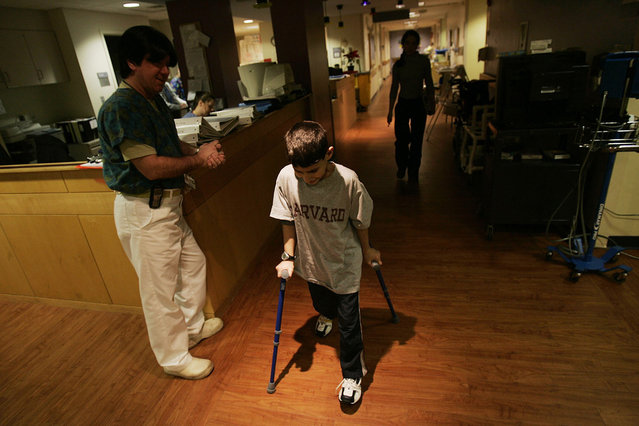
Rakan Hassan, 12, ambles about the halls of Spaulding Rehabilitation Hospital in Boston, Massachusetts, on January 11, 2006. Rakan's parents were shot and killed and he was gravely wounded by U.S. soldiers in an accidental shooting on January 18, 2005 in the northern Iraqi city of Tal Afar. The incident was widely publicized, and ultimately led to Rakan's treatment in Boston. With nerve damage to his abdomen and spine, doctors thought Rakan might never walk again, but an intensive physical therapy regimen has brought back the use of his legs and he can now walk with assistance. (Photo by Chris Hondros via The Atlantic)
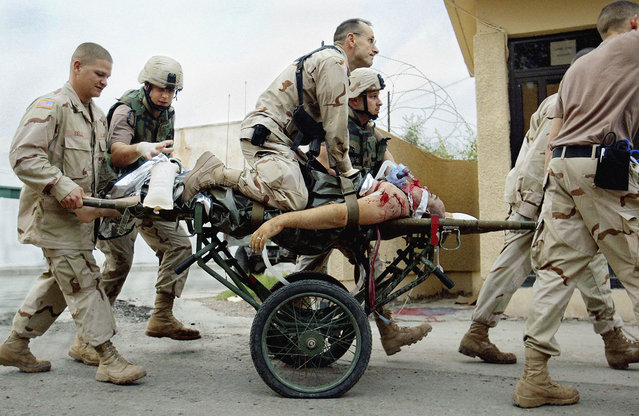
Combat Support Hospital Army Nurse supervisor Patrick McAndrew tries to save the life of an American soldier by giving him CPR upon arrival at the Combat Support Hospital in Baghdad, on April 4, 2005. (Photo by John Moore/AP Photo via The Atlantic)
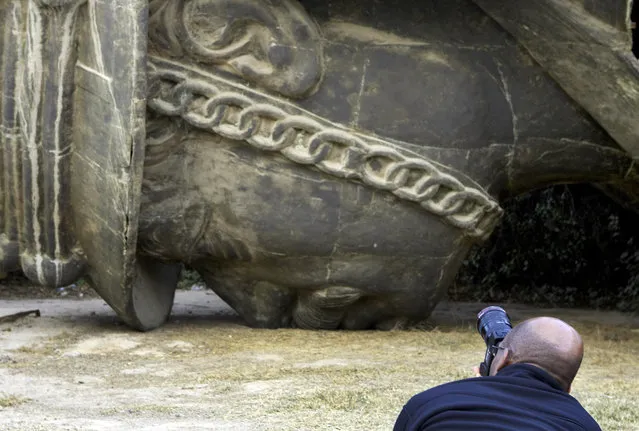
An American photographer takes pictures of a Saddam Hussein bust, lying face down in the heavily fortified Green Zone in Baghdad, on January 24, 2006. (Photo by Jacob Silberberg/AP Photo via The Atlantic)
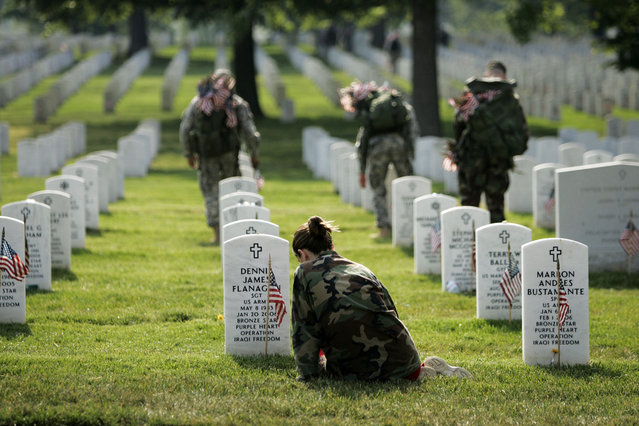
Kristin Kenney of Edison, New Jersey, sits at the grave of her boyfriend, Army Sgt. Dennis Flanagan, while Members of the 289th Military Police Honor Guard plant flags at grave sites at Arlington National Cemetery in Arlington, Virginia, on May 25, 2006. Flanagan died in Iraq on January 21, 2006. (Photo by Gerald Herbert/AP Photo via The Atlantic)
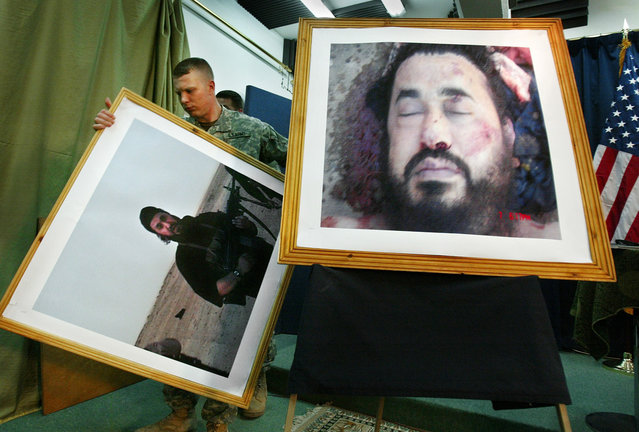
A U.S. soldier at a press conference in Baghdad, Iraq, takes down an older image, to display the latest image purporting to show the body of Abu Musab al-Zarqawi, the al-Qaida-linked militant who led a bloody campaign of suicide bombings, kidnappings and hostage beheadings in Iraq. Zarqawi was killed in a U.S. airstrike, Iraq's Prime Minister Nouri al-Maliki announced on June 8, 2006. (Photo by Khalid Mohammed/AP Photo via The Atlantic)
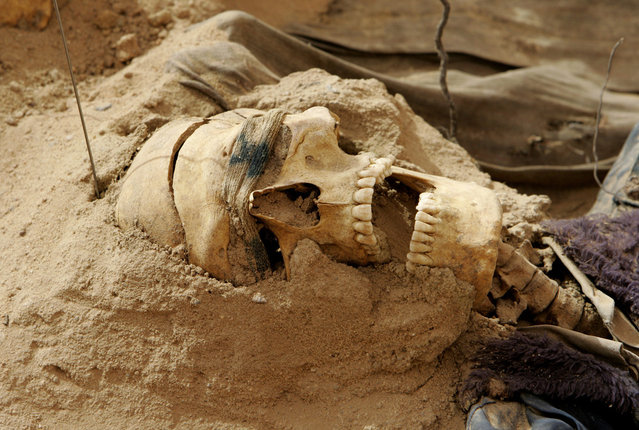
A human skull with blindfold still on lies on a mass grave containing human skeletons and clothes from persons allegedly executed during the regime of former President Saddam Hussein and now unearthed in a shallow grave, in a remote desert south of Baghdad in Iraq, on June 3, 2006. (Photo by Erik de Castro/AP Photo via The Atlantic)
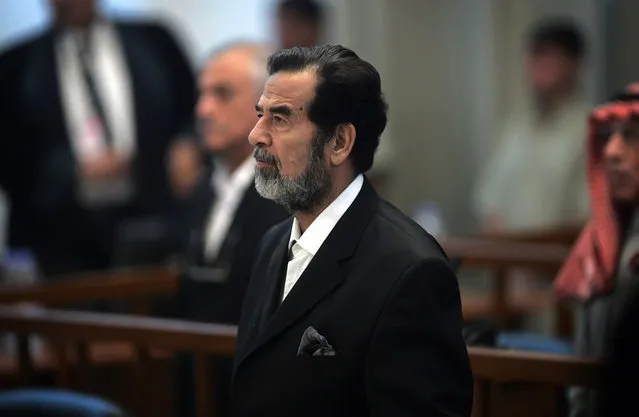
Saddam Hussein stands as an unseen witness is sworn in for testimony during his trial in Baghdad's heavily fortified Green Zone, in Iraq, on October 19, 2006. Saddam and six other co-defendants faced charges of war crimes and crimes against humanity for their roles in Operation Anfal, a military offensive against the Kurds in 1987–88. (Photo by David Furst/AP Photo via The Atlantic)
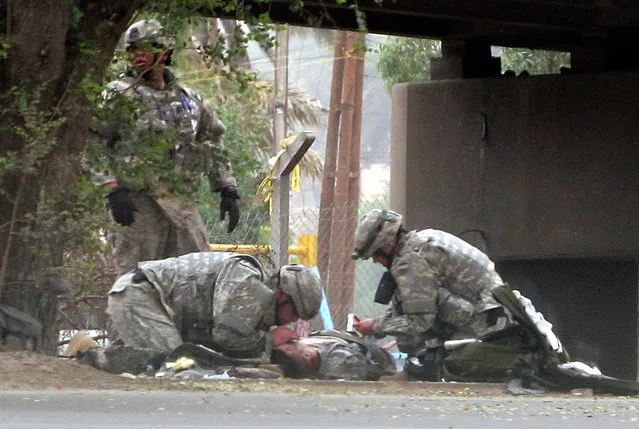
U.S. soldiers provide first aid to their colleague injured in an attack on their armored vehicle in Baghdad, on May 4, 2006. A roadside bomb hit a U.S. military convoy on a service road near the airport road. Witnesses said one soldier was wounded and evacuated by helicopter. (Photo by Hadi Mizban/AP Photo via The Atlantic)
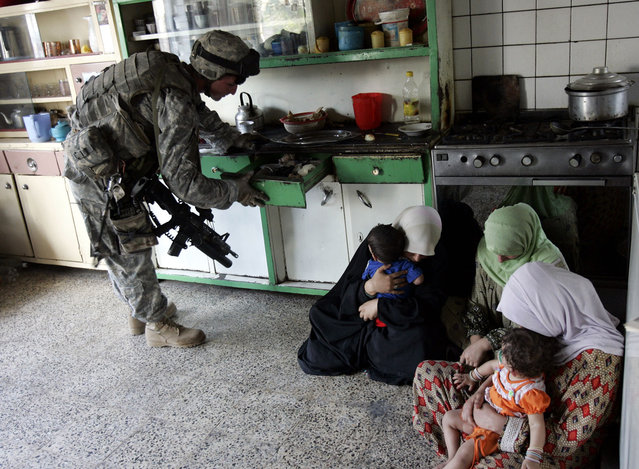
A U.S. soldier from Alpha company 1-17 regiment of the 172th brigade searches a house as women and children look on, in eastern Baghdad, on October 3, 2006. The U.S military has been performing scout missions aimed at preparing security operations to stop sectarian violence in the capital. (Photo by Darko Bandic/AP Photo via The Atlantic)
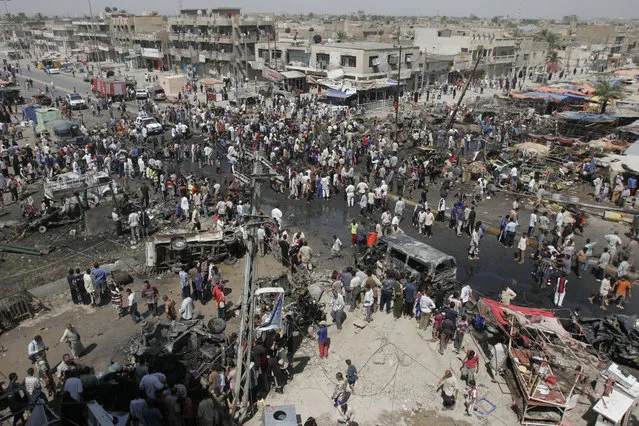
Hundreds of locals gather around the scene of a massive car bomb attack, on July 1, 2006, in the Sadr City area of Baghdad. A car bomb exploded in the morning outside of a popular Baghdad market killing 45 and wounding 41, while 14 vehicles and 22 shops and stalls were destroyed, said police. (Photo by Mohammed Hato/AP Photo via The Atlantic)

This video image released by Iraqi state television shows Saddam Hussein's guards wearing ski masks and placing a noose around the deposed leader's neck moments before his execution, on December 30. 2006. Clutching a Quran and refusing a hood, Saddam Hussein went to the gallows before sunrise, executed by vengeful countrymen after a quarter-century of remorseless brutality that killed countless thousands and led Iraq into disastrous wars against the United States and Iran. (Photo by AP Photo/IRAQI TV via The Atlantic)
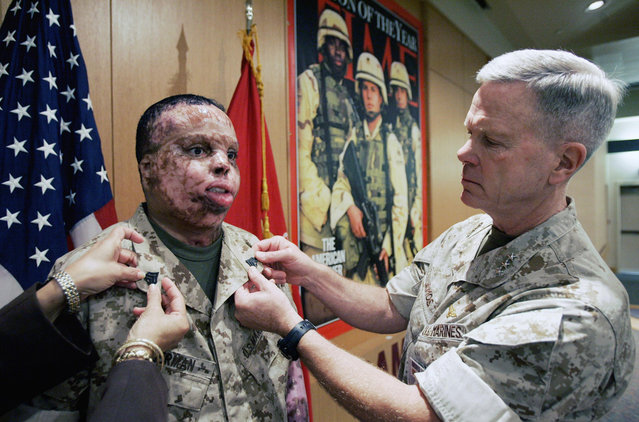
Marine Sgt. Merlin German (left) poses for photos with Lt. Gen. James F. Amos during German's promotion ceremony at Brooke Army Medical Center in San Antonio, on May 21, 2007. German was recovering from burns over 97 percent of his body caused by a roadside bomb in Iraq. He later died, in April of 2008, following a minor skin graft surgery. (Photo by Eric Gay/AP Photo via The Atlantic)
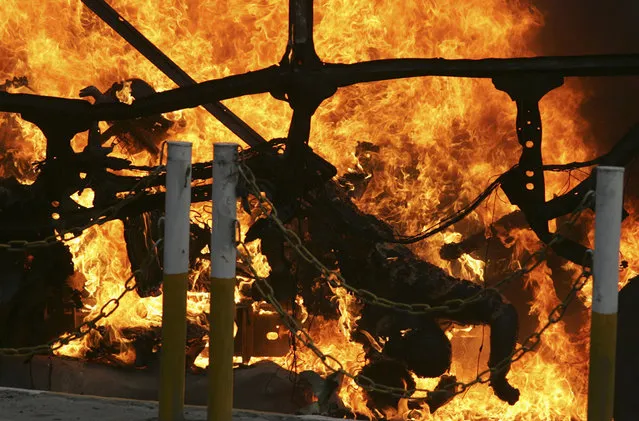
A person burns in a minibus shortly after a bomb attack in Baghdad, on January 21, 2007. A bomb killed two people and wounded seven when it destroyed a minibus in Karrada, in central Baghdad, police said. (Reuters/Namir Noor-Eldeen (Photo by IRAQ via The Atlantic)
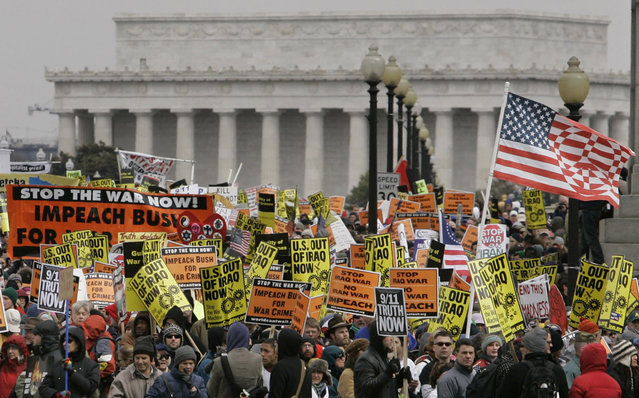
With the Lincoln Memorial in the background, demonstrators march over the Arlington Memorial Bridge from the National Mall to the Pentagon in Washington, on March 17, 2007 during a protest opposing the war in Iraq. (Photo by Gerald Herbert/AP Photo via The Atlantic)
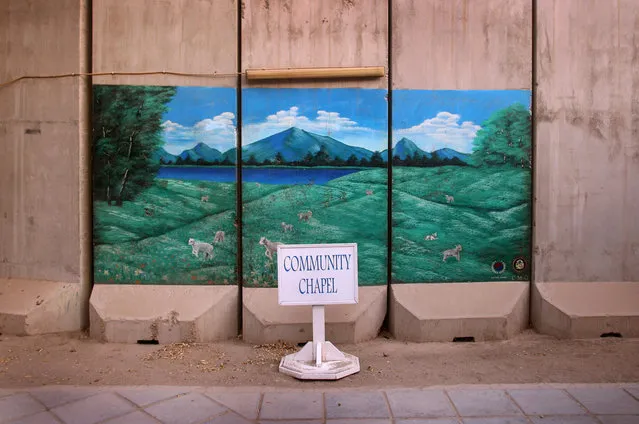
Concrete barriers adorned with a pastoral scene protect a chapel in the U.S. embassy compound in the Green Zone in Baghdad, on September 3, 2007. (Photo by John Moore via The Atlantic)
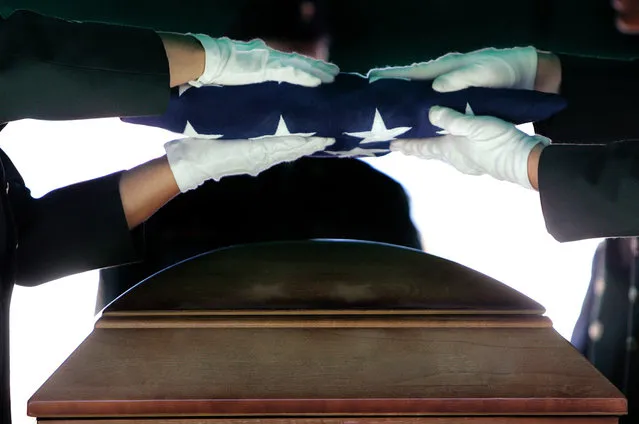
Members of a military honor guard fold the flag over the casket of Army Cpl. Jason Hernandez during graveside services in Streetsboro, Ohio, on September 17, 2007. Hernandez was killed by a roadside bomb on September 7, his 21st birthday, while serving in Mosul, Iraq. (Photo by Amy Sancetta/AP Photo via The Atlantic)
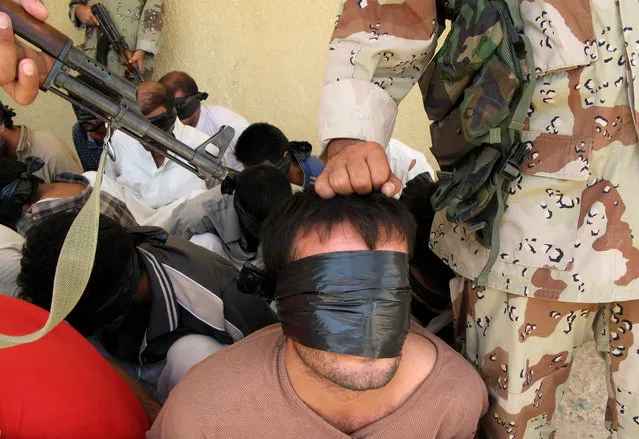
Iraqi soldiers guard a detainee that was arrested during an Iraqi Army operation just outside the city of Baqouba, on August 22, 2007. (Photo by AP Photo via The Atlantic)
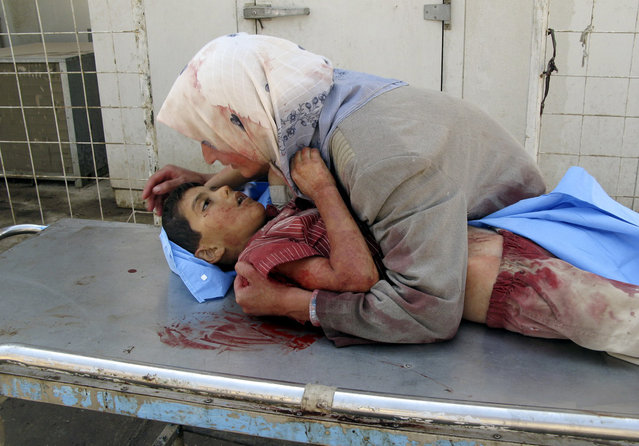
A woman takes her dead son into her arms, as she grieves for her six-year-old son, Dhiya Thamer, who was killed when their family car came under fire by unknown gunmen in Baqouba, 60 kilometers (35 miles) northeast of Baghdad, on September 16, 2007. The boy's ten-year old brother, Qusay, was injured in the attack as the family returned from enrolling the children in school, where Dhiya was to begin his first year. (Photo by Adem Hadei/AP Photo via The Atlantic)
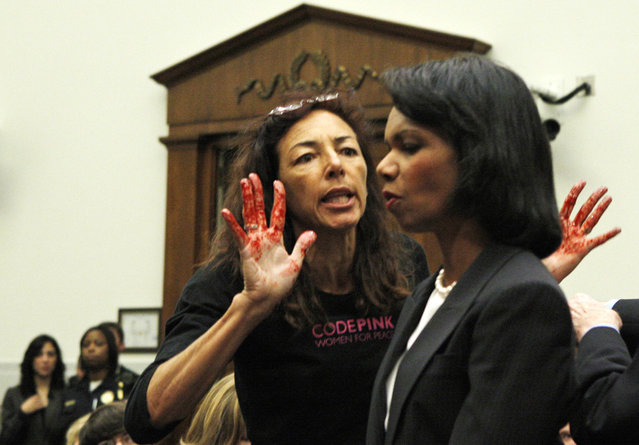
Secretary of State Condoleezza Rice, right, is confronted by Code Pink member Desiree Sairooz, her hands painted red, as she arrived to testify on Capitol Hill in Washington, on October 24, 2007, before the House Foreign Relations Committee hearing regarding US policy in the Middle East, where she spoke about Iraq, Iran, and the Israel Palestinian conflict. (Photo by Charles Dharapak/AP Photo via The Atlantic)
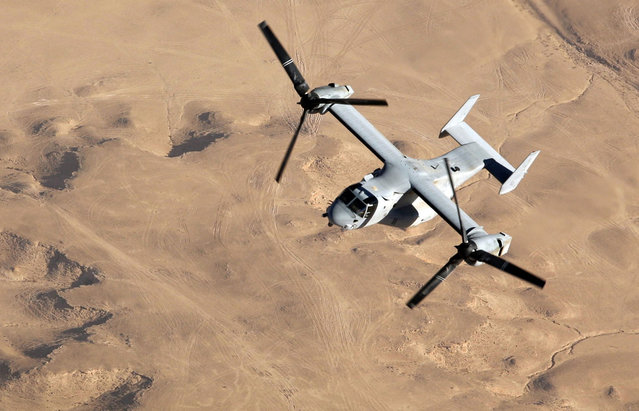
An MV-22B Osprey with Marine Medium Tilt rotor Squadron-263, flies over the Al Anbar Province of Iraq during a mission out of Al Asad Air Base, on November 10, 2007. (Photo by Cpl. Sheila M. Brooks/USMC via The Atlantic)
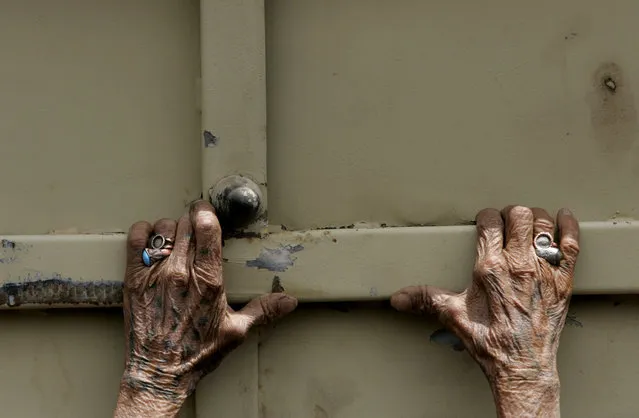
An Iraqi woman holds onto a truck while waiting for food supplies to be distributed by Iraqi soldiers among the residents of the Shi'ite enclave of Sadr city in Baghdad, Iraq, on May 8, 2008. (Photo by Petr David Josek/AP Photo via The Atlantic)
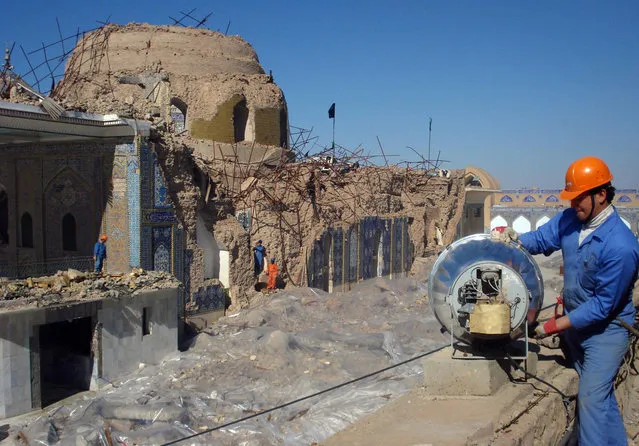
Iraqi workers begin a reconstruction project aimed at restoring the destroyed historic shrine of the Shiite Imam al-Askari in the northern city of Samrra on February 5, 2008. Work began on restoring the revered shrine, badly damaged in a bombing that unleashed a wave of bitter sectarian violence across Iraq almost two years previous, an AFP correspondent said. (Photo by Dia Hamid/AFP Photos via The Atlantic)
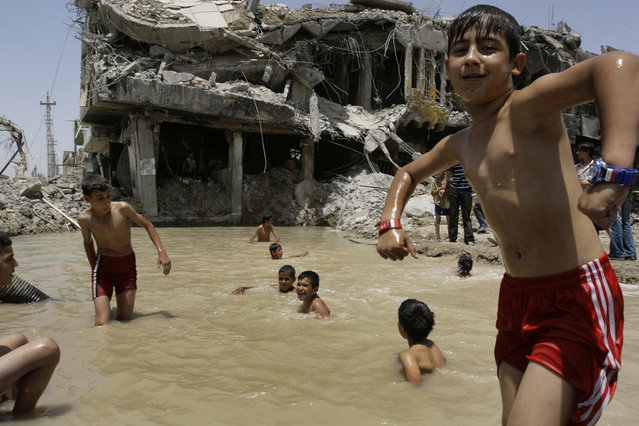
Iraqi boys swim in a pond by a house destroyed in recent fighting in Sadr City in Baghdad, Iraq, on May 20, 2008. (Photo by Karim Kadim/AP Photo via The Atlantic)
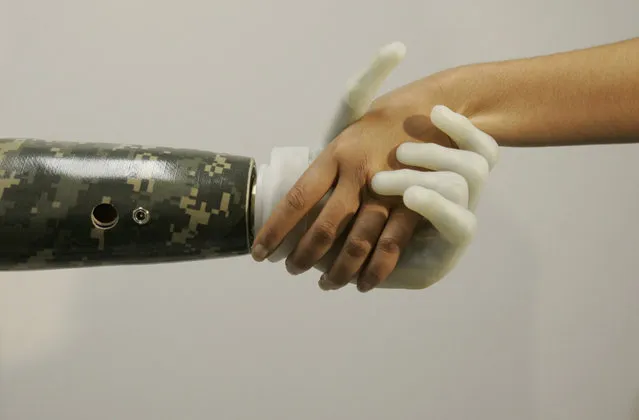
Iraq war veteran Sgt. Juan Arredondo, one of the first recipients of a bionic hand with independently moving fingers called the i-Limb, shakes a reporters hand during an interview on July 23, 2007 in New York. Arredondo's bionic hand has finger “joints” that flex and bend like natural fingers. (Photo by Mary Altaffer/AP Photo via The Atlantic)
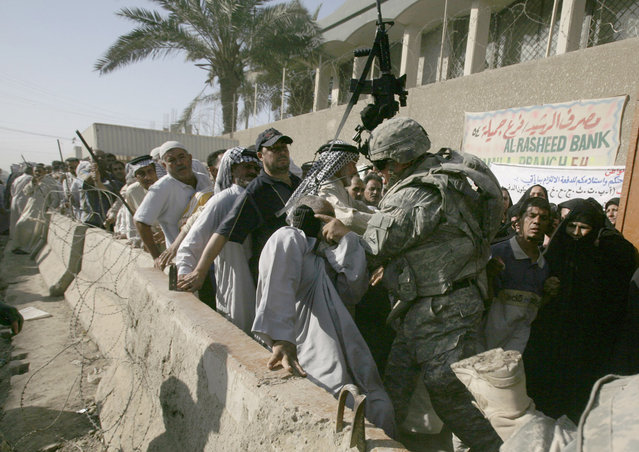
Sgt. Kyle Hale of Yukon, Oklahoma, of 1-6 battalion, 2nd brigade, 1st Armored Division, contains an unruly crowd to protect a man who was nearly trampled, outside the Al Rasheed Bank in the in Jamilah market in Sadr city, Baghdad, on June 10, 2008. (Photo by Petros Giannakouris/AP Photo via The Atlantic)
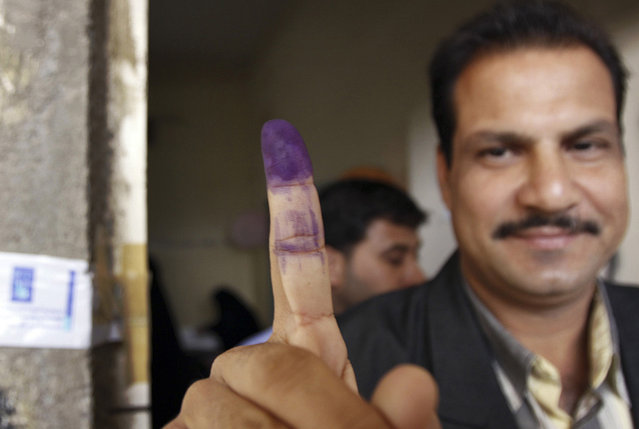
An Iraqi man holds up an ink-stained finger after casting his vote in the country's provincial elections in Basra, Iraq's second-largest city, on January 31, 2009. (Photo by Nabil al-Jurani/AP Photo via The Atlantic)
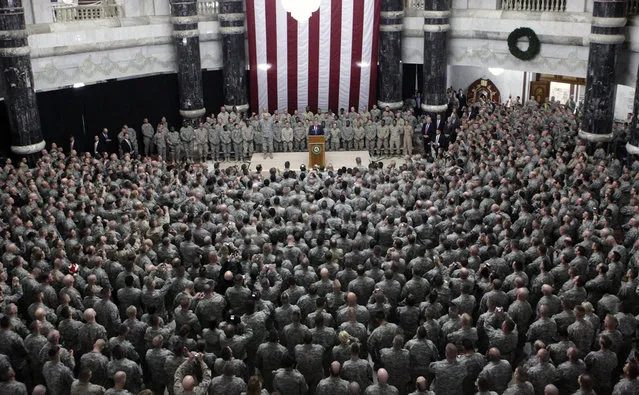
President George W. Bush speaks with U.S. troops at Camp Victory, on December 14, 2008 in Baghdad. (Photo by Evan Vucci/AP Photo via The Atlantic)
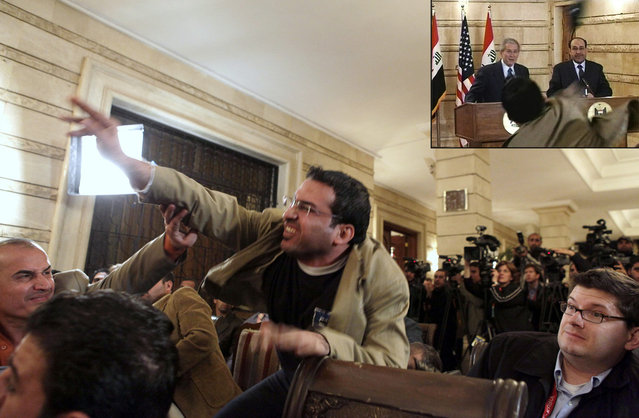
An Iraqi man throws a shoe at President George W. Bush (seen ducking the shoe in inset image) during a news conference with Iraq Prime Minister Nouri al-Maliki on December 14, 2008, in Baghdad. Muntadhar al-Zaidi, an Iraqi broadcast journalist threw two shoes at Bush, one after another, during the news conference. Bush ducked both throws. As he threw the shoes, al-Zaidi reportedly shouted “This is a farewell kiss from the Iraqi people, you dog”, and “This is for the widows and orphans and all those killed in Iraq”. Muntadhar al-Zaidi was dragged away by security, arrested, and spent nine months in prison for the incident. (Photo by Evan Vucci/AP Photo/Inset/APTN via The Atlantic)
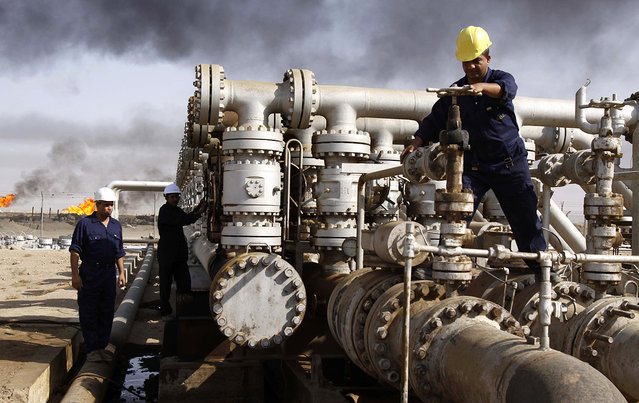
Iraqi workers at the Rumaila oil refinery, near the city of Basra, on December 13, 2009. (Photo by Nabil al-Jourani/AP Photo via The Atlantic)
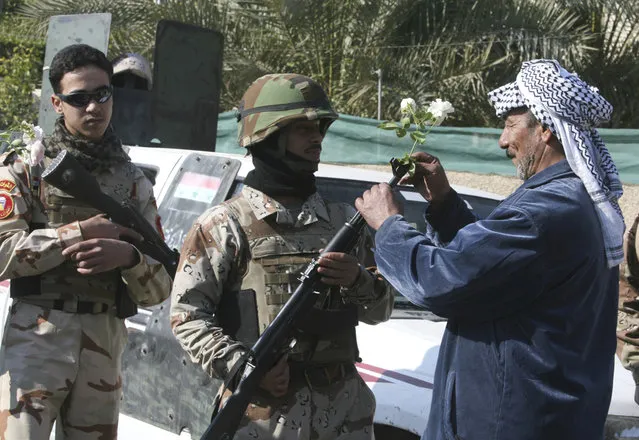
An Iraqi man places flowers in the barrel of a soldier's gun moments before a suicide attack on a celebration marking Army Day in the Karradah neighborhood of central Baghdad, on January 6, 2008. (Photo by Hadi Mizban/AP Photo via The Atlantic)
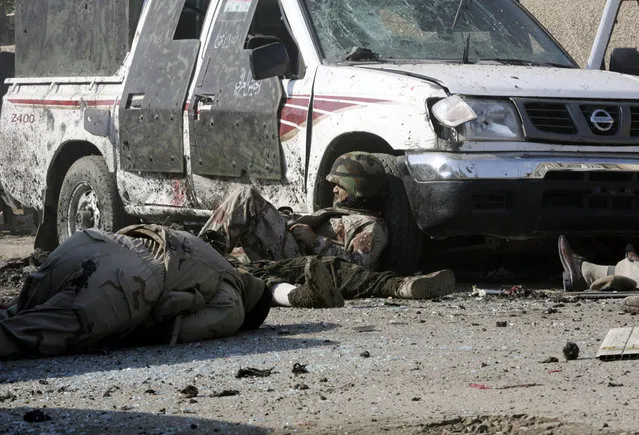
Iraqi Army soldiers lay dead and wounded moments after a suicide attack on a celebration marking Army Day in the Karradah neighborhood of central Baghdad, on January 6, 2008. Two Iraqi army soldiers threw themselves atop a suicide bomber, but the attacker was able to detonate an explosives vest, killing the two soldiers and another nine people. The civilian from the previous photo was among those killed, his foot visible at right. (Photo by Hadi Mizban/AP Photo via The Atlantic)
20 Mar 2013 08:50:00,
post received
0 comments
